UNESCO Sites in Central Asia
UNESCO Sites in Central Asia
Central Asia has 14 places of important cultural or natural value that have been recognized by the United Nations Educational, Scientific and Cultural Organization (UNESCO). There are 3 UNESCO sites in Uzbekistan, 1 in Kyrgyzstan, 2 in Tajikistan, 3 in Kazakhstan and 3 in Turkmenistan. In addition, there are also the Western Tien Shan that is located within the Kyrgyzstan, Kazakhstan and Uzbekistan states and the “Silk Roads: the Routes Network of Chang’an-Tianshan Corridor” covering the network of cities along a northern route of Silk road in Kazakhstan and Kyrgyzstan.
Central Asia Guide offers tours to all UNESCO sites through Central Asia Tours or the country specific tours and the are the best way to experience the cultural legacy and natural beauty of this region. Please contact us if you wish to organize a tour focusing only on the UNESCO sites of Central Asia.
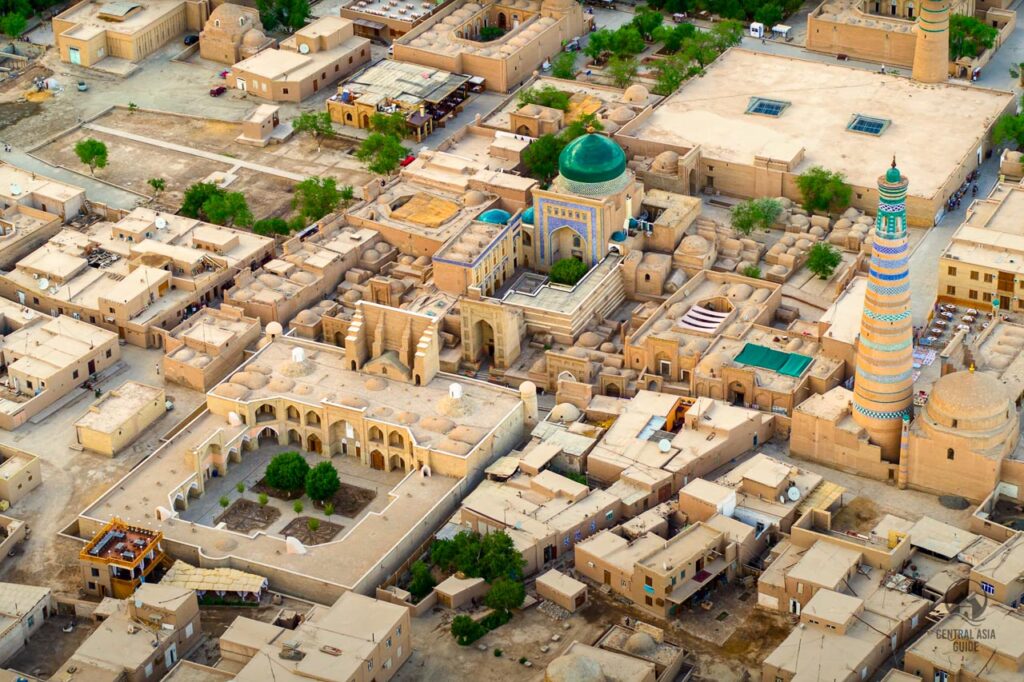
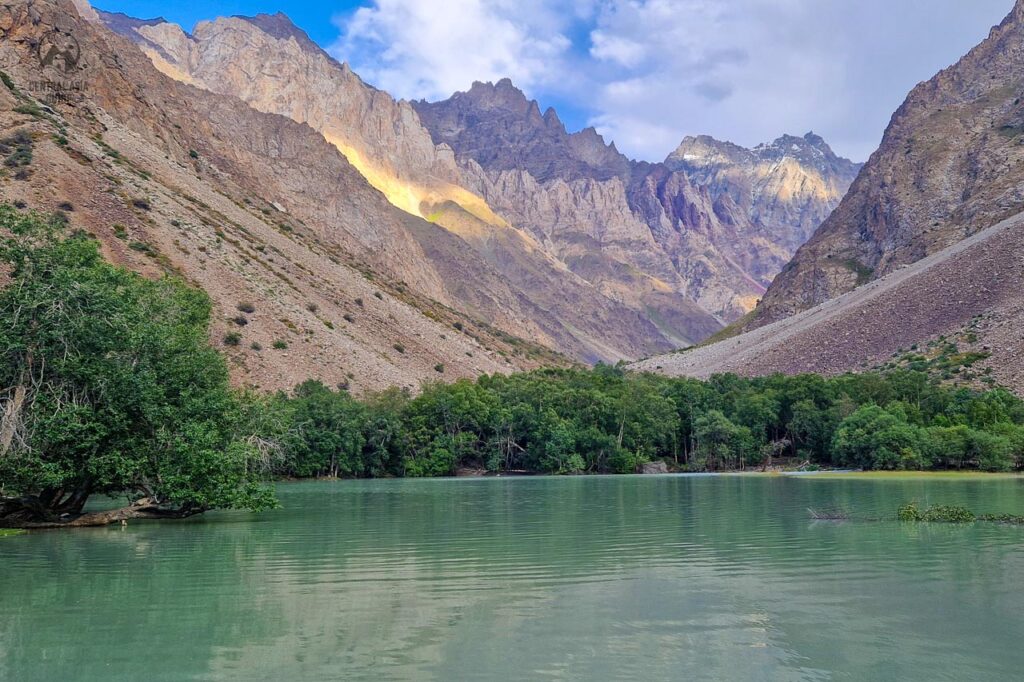
UNESCO Sites in Uzbekistan
The Unesco sites in Uzbekistan focus on the Silk Road era cities that used to be centers of trade or the main cities of the Timurid Empire with great islamic style architecture. Most of our Uzbekistan Tours include at least some of the sites mentioned below.
Historic Centre of Bukhara
The Historic Centre of Bukhara, situated on one of the branches of the Silk Roads, is more than two thousand years old. It is one of the best examples of well preserved Islamic cities of Central Asia from 10th to 17th centuries, with a very intact old town center area that takes you back to the stories of the Arabian Nights. Bukhara was for long an important economic and cultural center in Central Asia. This ancient Persian city served as a major center of Islamic culture for many centuries and became a major cultural center of the Caliphate in the 8th century.
With the exception of a few sights from before the Mongol invasions of Genghis Khan in 1220 and Temur in 1370, the old town boasts with an amazing number of architecture of the Sheibani period of Uzbek rule, from the early 16th century onwards. The sights that survived from the invasions are the Ismail Samanai Tomb and the Poi Kalyan minaret together with the Attori mosque and the Chashma Ayub shrine.


The Ulugbek madrassa is a survivor from the Temurid era and with the Sheibanids buildings like the rest of the Poi-Kalyan group, the Lyabi-Khauz ensemble, the Kosh Medresseh and the Gaukushon medresseh in the Hodja-Kalon ensemble saw their birth. Later significant buildings include for example Taki Sarafon (Trading Dome of the Moneychangers), Taki-Tilpak-Furushan (Trading Dome of the Headguard Sellers), Tim-Bazzazan and Tiro-Abdullah-Khan. Even later, in the early 17th century several great buildings were added, including a new great mosque, Magoki Kurns (1637), and the imposing Abdullaziz-Khan medresseh (1652).
But the real significance of Bukhara is not in its individual buildings but in its overall unified and well survived old town that really take you to the .
Samarkand - Crossroads of Cultures
The historic town of Samarkand, located in a large oasis in the valley of the Zerafshan River, in North-Eastern Uzbekistan, is considered the crossroads of world cultures with a history of over three and a half millennia. Evidence of settlements in the region goes back to 1500 BC, with Samarkand having its most significant development in the Temurid (Tamerlane) period, from the 14th to the 15th centuries, when it was capital of the powerful Temurid empire.
The historical part of Samarkand consists of three main sections. In the north-east there is the site of the ancient city of Afrosiab, founded in the 7th century BC and destroyed by Genghis Khan in the 13th century, which is preserved as an archaeological reserve. Archaeological excavations have revealed the ancient citadel and fortifications, the palace of the ruler (built in the 7th century displays important wall paintings), and residential and craft quarters. There are also remains of a large ancient mosque built from the 8th to 12th centuries.


To the south, there are architectural ensembles and the medieval city of the Temurid epoch of the 14th and 15th centuries, which played a seminal role in the development of town planning, architecture, and arts in the region. The old town area has retained substantial areas of historic fabric with typical narrow lanes, articulated into districts with social centres, mosques, madrassahs, and residential housing. The traditional Uzbek houses have one or two floors and the spaces are grouped around central courtyards with gardens; built in mud brick, the houses have painted wooden ceilings and wall decorations.
To the west, there is the area that corresponds to the 19th and 20th centuries expansions, built by the Russians, in European style which gives Samarkand a very different feeling compared to Tashkent which was heavily rebuilt after the famous earthquake that leveled the city. This area represents traditional continuity and qualities that are reflected in the neighbourhood (Mahalla) structure, the small centres, mosques, and houses. Many houses retain painted and decorated interiors, grouped around courtyards and gardens.
The major monuments of Samarkand include the Registan mosque and madrasahs, originally built in mud brick and covered with decorated ceramic tiles, the Bibi-Khanum Mosque and Mausoleum, the Shakhi-Zinda compound, which contains a series of mosques, madrasahs and mausoleum, and the ensembles of Gur-Emir and Rukhabad, as well as the remains of Ulugh-Bek’s Observatory.
Historic Centre of Shahrisabz
The Historic Centre of Shahrisabz (Shakhrisyabz), located on the Silk Roads in southern Uzbekistan, is over 2000 years old and was the cultural and political centre of the Kesh region (Former name of Shahrisabz was Kesh) in the 14th and 15th century. It contains a collection of exceptional monuments and ancient quarters which bear witness to the city’s secular development, particularly to the period of its apogee, under the rule of Amir Temur (Timur or Tamerlane) and the Temurids, in the 15th-16th century.
Shakhrisyabz rose to prominence in the 14th century as it was the birthplace of Tamerlane (1336-1405), founder of the Timurid dynasty. Tamerlane had a tomb for himself prepared there, although he would instead be buried in a new mausoleum built in Samarkand. The city contains not only outstanding monuments dating from the period of the Temurids, but also mosques, mausoleums, and entire quarters of ancient houses.
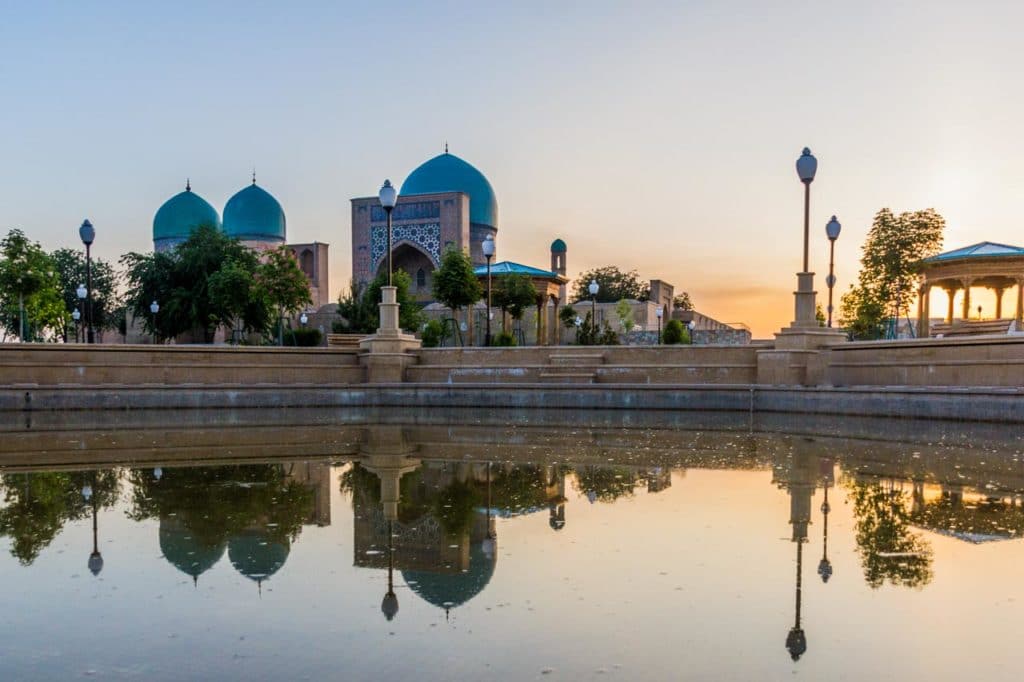

Ak-Sarai Palace construction began in 1380, the year following Temur’s conquest of Khorezm. Its immense gate is an architectural masterpiece, outstanding in its dimensions and bold design. Dorus Saodat is a vast complex which was destined as a place of burial for the ruling family. It contained, in addition to the tombs themselves, a prayer hall, a mosque, and accommodation for the religious community and pilgrims.
Other buildings of the historical center include the covered Chor-su bazaar that was built at the cross-roads of two main streets, in the form of an octagon with a central cupola. Despite the inroads of time, the remaining vestiges are still impressive in the harmony and strength of styles, an enriching addition to the architectural heritage of Central Asia and the Islamic world. However, it’s worth noting that in 2016, the Shahrisabz site was included in the list of World Heritage Sites in danger due to the destruction of a large part of its historic centre.
Ichan Kala of Khiva
Itchan Kala, the walled inner town of Khiva, is a coherent ensemble of Islamic architecture in the Khorezm region that dates from the 14th to the 19th century. It was the last resting place of caravans before crossing the Kara Kum desert to Persia (through current Turkmenistan). The old town is completely surrounded by brick city walls, which have four gates at the cardinal points. Among the buildings, the Djuma mosque and the many mausoleums and madrassas compete with the palaces of Khans, as well as traditional domestic architecture.
The town is very heavily, but also quite well restored and operates virtually as an open-air museum even though there are still many locals also living inside the walls. One can best soak up the atmosphere in the early mornings or evenings. Recommended sights are the Kunya Ark and its viewing platform, Tash Hauli’s Harem, the unfinished Kalta Minor and the Djuma Mosque (with the least claustrophobic minaret to climb).


UNESCO Sites in Kyrgyzstan
Sulaiman-Too Sacred Mountain
The only UNESCO site fully in Kyrgyzstan is the Sulaiman-Too Sacred Mountain which is a sacred mountain originating from pre-Islamic times. The cult practices for mountain worship have been continuing here for thousands of years but have been absorbed by Islam. The mountain has a height of ca. 200 m and overshadows the city of Osh in Southern Kyrgyzstan in the Fergana Valley at the crossroads of important routes on the Central Asian Silk Roads. Its five peaks and slopes contain numerous ancient places of worship and caves with 101 recognized petroglyph sites of which some are unfortunately damaged by graffiti.
On it, Stone and Bronze Age settlements, petroglyphs, ritual sites and Islamic buildings can be found. The walk on the network of traditional pilgrim paths is considered the best feature of Sulaiman Too, and you will meet many locals doing their daily rounds and seek for blessings. The site contains 17 places of worship, which are still in use, and many that are not. The cult sites are believed to provide cures for barrenness, headaches, and back pain and give the blessing of longevity. The Soviet museum, carved into the mountain can be considered disturbing but can also be interesting for the ones interested in Soviet architecture. On the top of the hill there is a small mosque linked to first Mughal emperor called Babur.
Sulaiman Too is believed to represent the most complete example of a sacred mountain anywhere in Central Asia, worshipped over several millennia. Suleiman Too is included in our Kyrgyzstan Tours that take you through the Southern part of Kyrgyzstan.
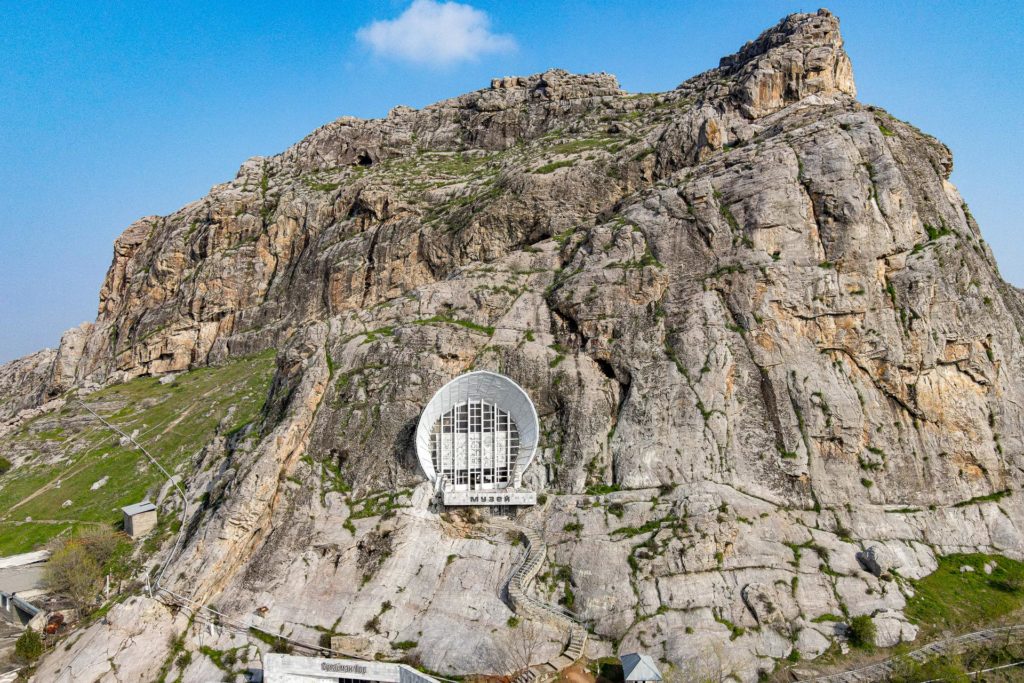
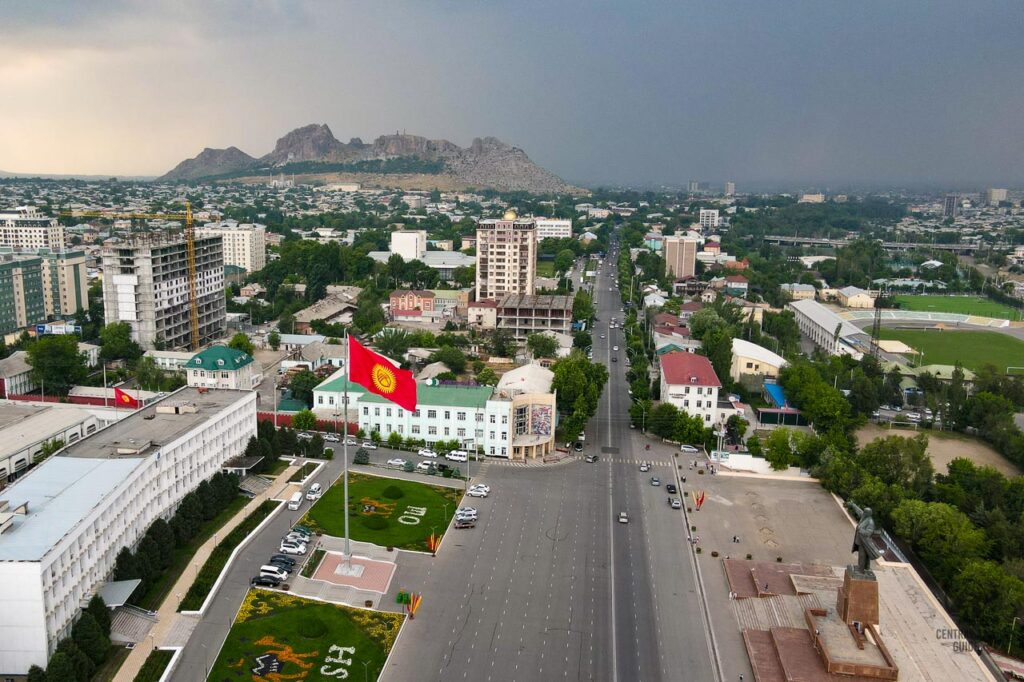
UNESCO sites in Kazakhstan
As Kazakhstan is huge, it is only natural that the UNESCO site of Kazakhstan are spread around and not so easy to combine in all the Kazakhstan Tours that we provide. In case you wish to visit any of the site below, please contact us.
Saryarka – Steppe and Lakes of Northern Kazakhstan
“Saryarka – Steppe and Lakes of Northern Kazakhstan” protects largely undisturbed steppe and wetland areas that are essential for migratory waterbirds. The site comprises Naurzum State Nature Reserve and Korgalzhyn State Nature Reserve, which includes the vast Korgalzhyn-Tengiz lake system where millions of migratory birds feed annually on their way from Africa to Siberia. The steppe is the habitat of the formerly critically endangered Saiga antelope.
The protected areas under Saryarka feature wetlands of outstanding importance for migratory water birds, including globally threatened species, among them the extremely rare Siberian white crane, the Dalmatian pelican, Pallas’s fish eagle, to name but a few. The 200 000 ha Central Asian steppe areas included in the property provide a valuable refuge for over half the species of the region’s steppe flora that bloom in vibrant colors during the sprint time and a number of threatened bird species. The property includes two groups of fresh and salt water lakes situated on a watershed between rivers flowing north to the Arctic and south into the Aral-Irtysh basin.

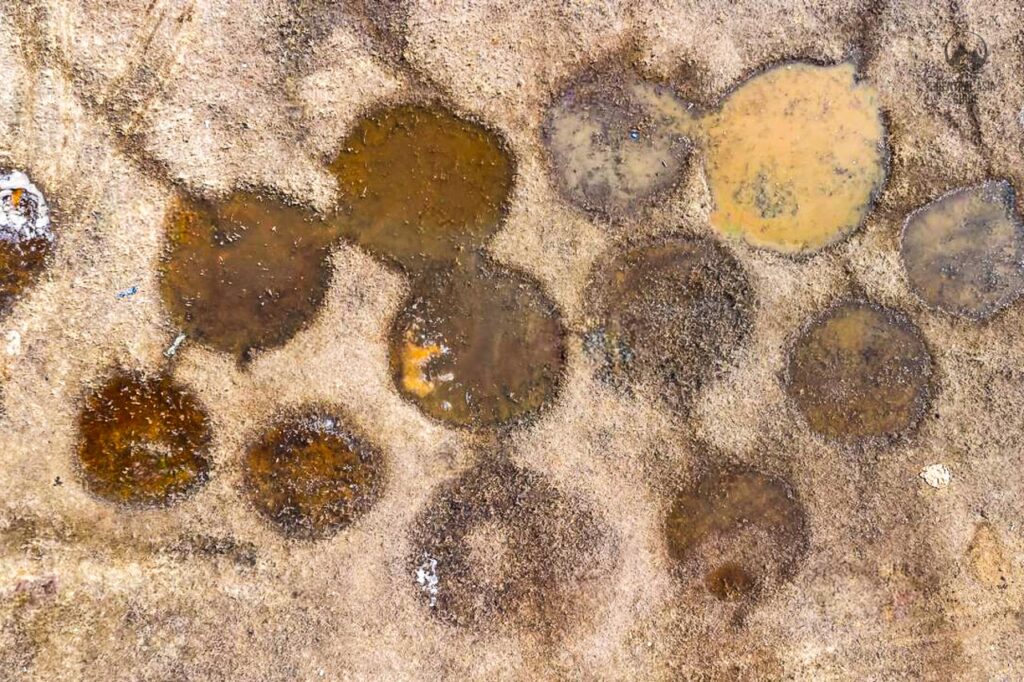
In the two protected areas of Korgalzhyn State Nature Reserve and Naurzum State Nature Reserve, the lakes and grassy landscapes of Saryarka provide sanctuary for millions of migratory birds. On annual journeys from Europe, Asia, and Africa, the birds stop in the wetlands reserves to nest and feed as they continue towards breeding grounds in Siberia. These protected areas are critical for the conservation of many endangered species. The combination of fresh and saltwater in the watersheds contributes to a unique wetland ecosystem and incredible biodiversity across the steppe.
Mausoleum of Khoja Ahmed Yasawi
The Mausoleum of Khoja Ahmed Yasawi, in the town of Yasi, now Turkestan, was built at the time of Timur (Tamerlane), from 1389 to 1405. In this partly unfinished building, Persian master builders experimented with architectural and structural solutions later used in the construction of Samarkand, the capital of the Timurid Empire. Today, it is one of the largest and best-preserved constructions of the Timurid period.
Built between 1389 and 1405, by order of Timur, the ruler of Central Asia at the time, it replaced a smaller 12th century mausoleum. Construction of the building was halted in 1405, with the death of Timur, and was never completed. The property, burials and remains of the old town offer significant testimony to the history of Central Asia. The mausoleum is closely associated with the diffusion of Islam in this region with the help of Sufi orders, and with the political ideology of Timur.

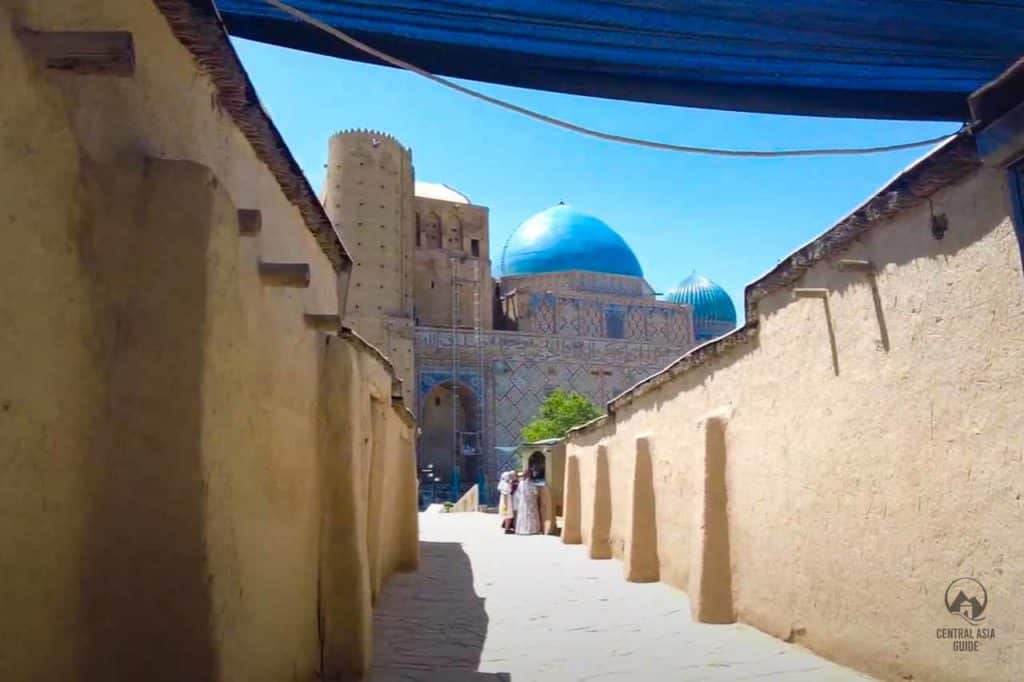
Petroglyphs of the Archaeological Landscape of Tanbaly
Set around the lush Tanbaly Gorge, amidst the vast, arid Chu-Ili mountains, is a remarkable concentration of some 5 000 petroglyphs (rock carvings) dating from the second half of the second millennium BC to the beginning of the 20th century. Distributed among 48 complexes with associated settlements and burial grounds, they are testimonies to the husbandry, social organization and rituals of pastoral peoples. Human settlements in the site are often multilayered and show occupation through the ages. A huge number of ancient tombs are also to be found including stone enclosures with boxes and cists (middle and late Bronze Age), and mounds (kurgans) of stone and earth (early Iron Age to the present). The central canyon contains the densest concentration of engravings and what are believed to be altars, suggesting that these places were used for sacrificial offerings. Tanbaly petroglyphs site visit can be included to a tour visiting the Altyn Emel national park with the famous singing dune.
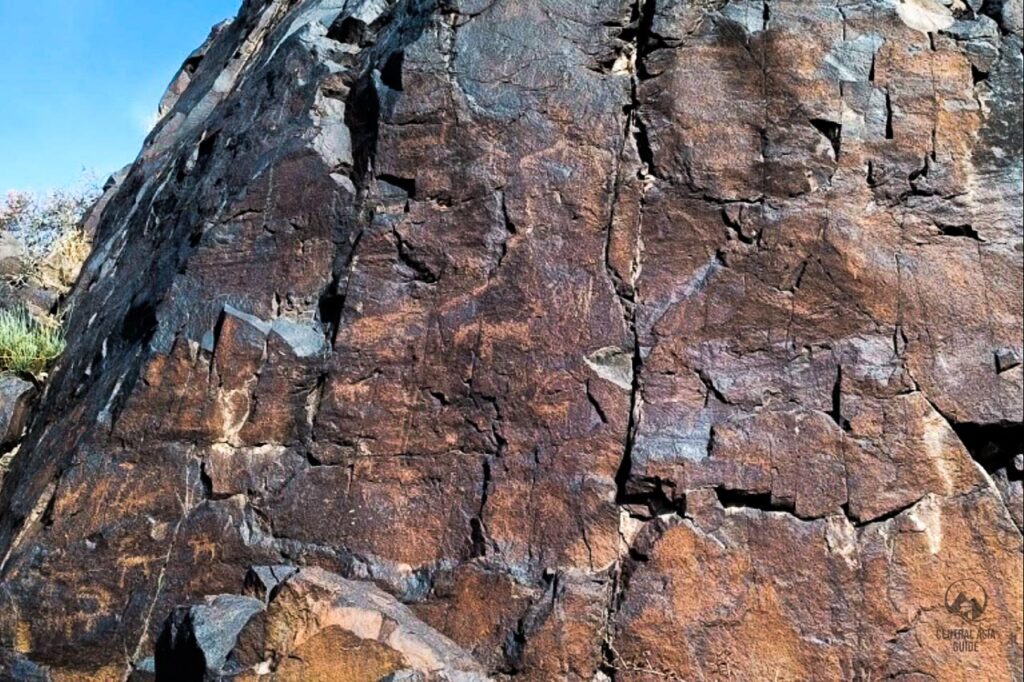

UNESCO sites in Tajikistan
Proto-urban Site of Sarazm
Sarazm, which means “where the land begins”, is an archaeological site bearing testimony to the development of human settlements in Central Asia, from the 4th millennium BCE to the end of the 3rd millennium BCE near the current Panjakent. The ruins demonstrate the early development of proto-urbanization in this region. This centre of settlement, one of the oldest in Central Asia, is situated between a mountainous region suitable for cattle rearing by nomadic pastoralists in the Zerafshan river valley, and a large valley conducive to the development of agriculture and irrigation by the first settled populations in the region. Sarazm also demonstrates the existence of commercial and cultural exchanges and trade relations with peoples over an extensive geographical area, extending from the steppes of Central Asia and Turkmenistan, to the Iranian plateau, the Indus valley and as far as the Indian Ocean. Sarazm is also easily visited while trekking in Fann mountains or from Samarkand.

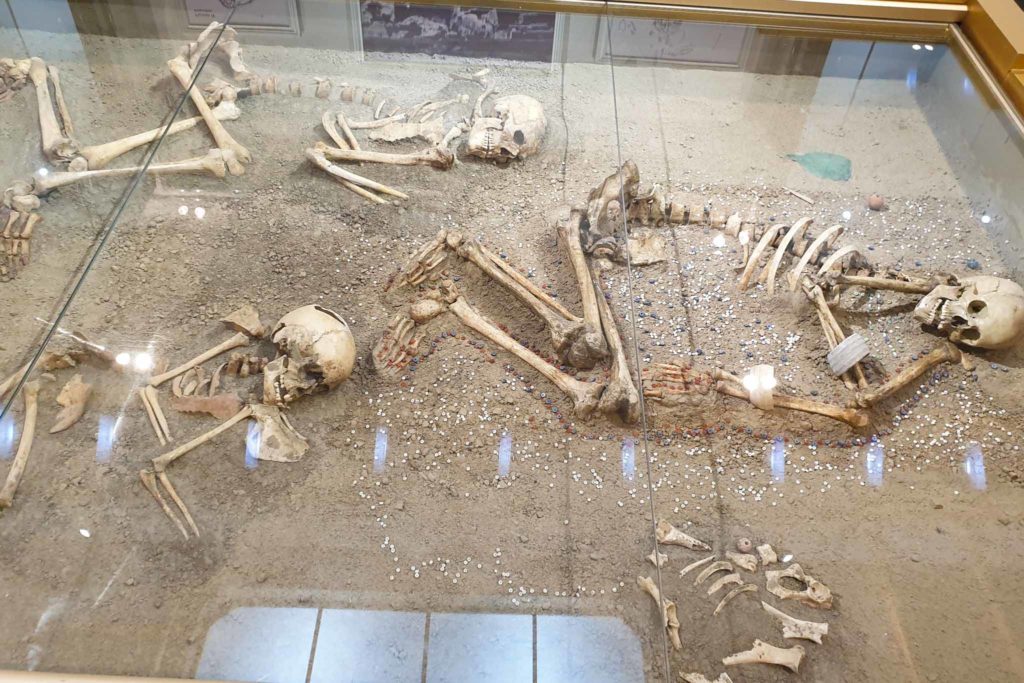
Tajik National Park (Mountains of the Pamirs)
Tajikistan National Park covers more than 2,5 million hectares in the east of the country, at the centre of the so-called “Pamir Knot”, a meeting point of the highest mountain ranges on the Eurasian continent. It consists of high plateaus in the east and, to the west, rugged peaks, some of them over 7 000 meters high, and features extreme seasonal variations of temperature. The longest valley glacier outside the Polar region called Fedchenko Glacier is located among the 1 085 glaciers inventoried in the site, which also numbers 170 rivers and more than 400 lakes.
Rich flora species of both the south-western and central Asian floristic regions grow in the Park which shelters nationally rare and threatened birds and mammals (Marco Polo Argali sheep, Snow Leopards and Siberian Ibex and more). Subject to frequent strong earthquakes, the Park is sparsely inhabited, and virtually unaffected by agriculture and permanent human settlements. It offers a unique opportunity for the study of plate tectonics and subduction phenomena.
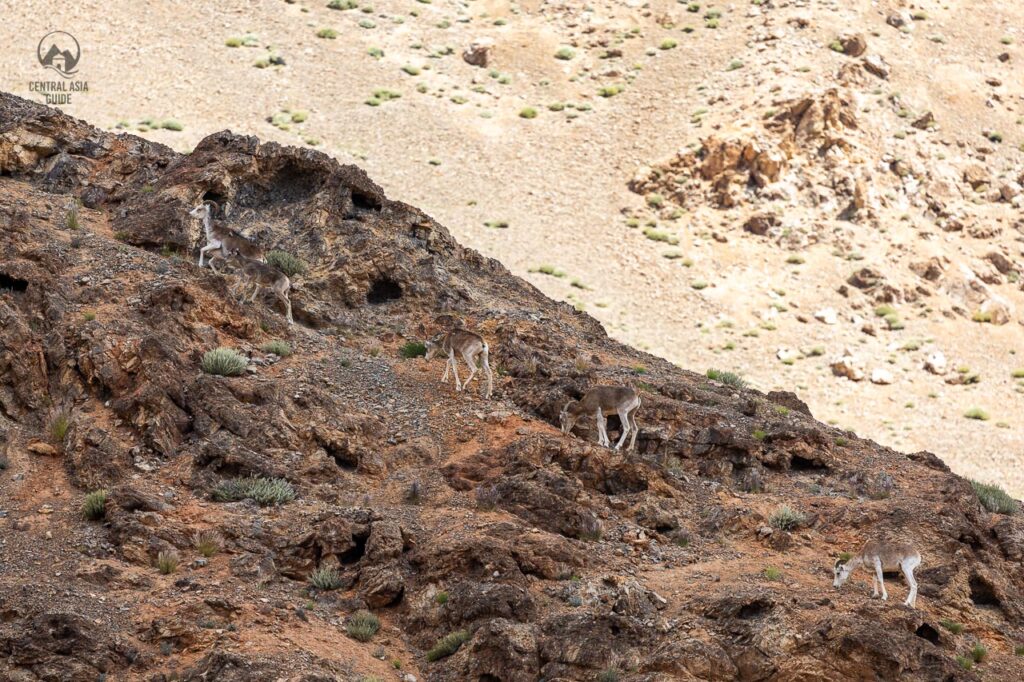
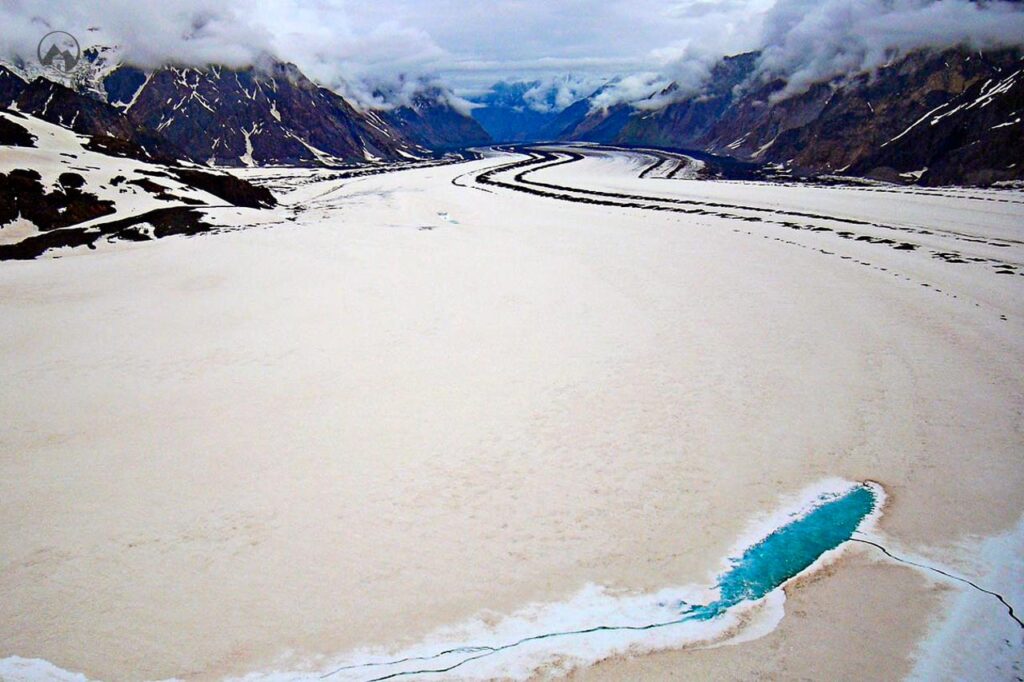
UNESCO sites in Turkmenistan
All the UNESCO site of Turkmenistan are included at least in some of our Turkmenistan Tours. Nisa and Merv are conveniently located in the proximity of Ashgabat, but to venture to Konye Urgench, requires somewhat more time but can be combined with visiting the Darwaza burning crater.
State Historical and Cultural Park “Ancient Merv”
The State Historical and Cultural Park called the “Ancient Merv” is a UNESCO World Heritage Site located near the current city of Mary. It is the oldest and most completely preserved of the oasis cities along the Silk Roads in Central Asia and in the Karakum desert.
The remains in this vast oasis span 4000 years of human history. A number of monuments are still visible, particularly from the last two millennia. The site includes also older remains of Bronze Age (2500-1200 BC) and Iron age (1200-300 BC) dwellings and the the historic urban center and the post-medieval city called Abdullah Khan Kala.
The historic urban center of Merv consists of a series of adjacent walled cities: Erk Kala, Gyaur Kala and the medieval Sultan Kala or Marv al-Shahijan. The Mausoleum of Sultan Sanjar (1118-57) is one of the most outstanding architectural achievements of the Seljuk period.
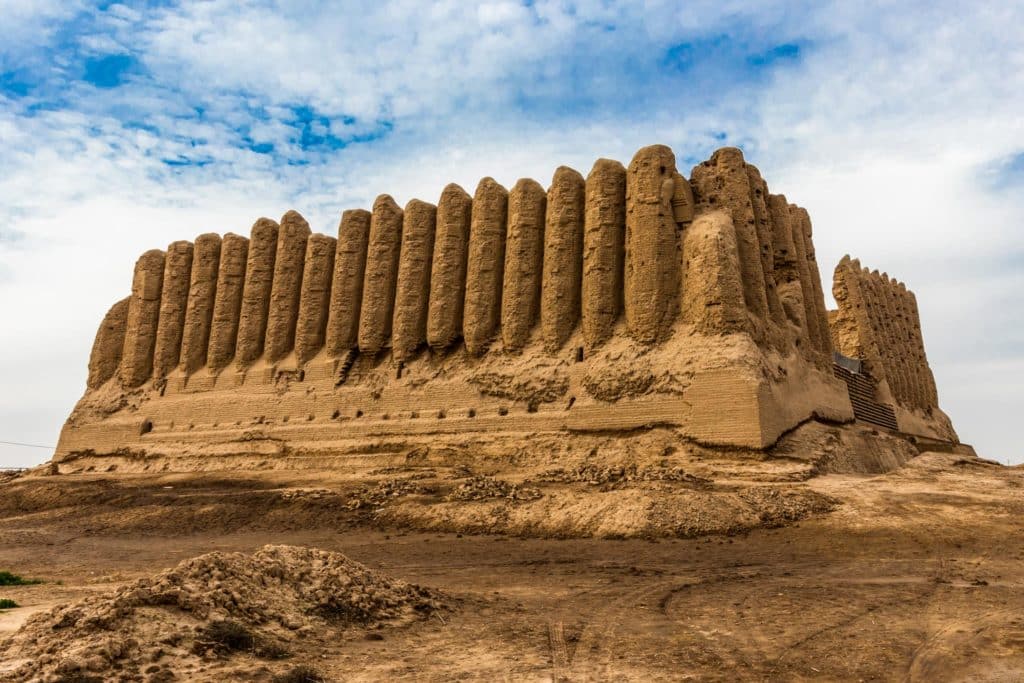
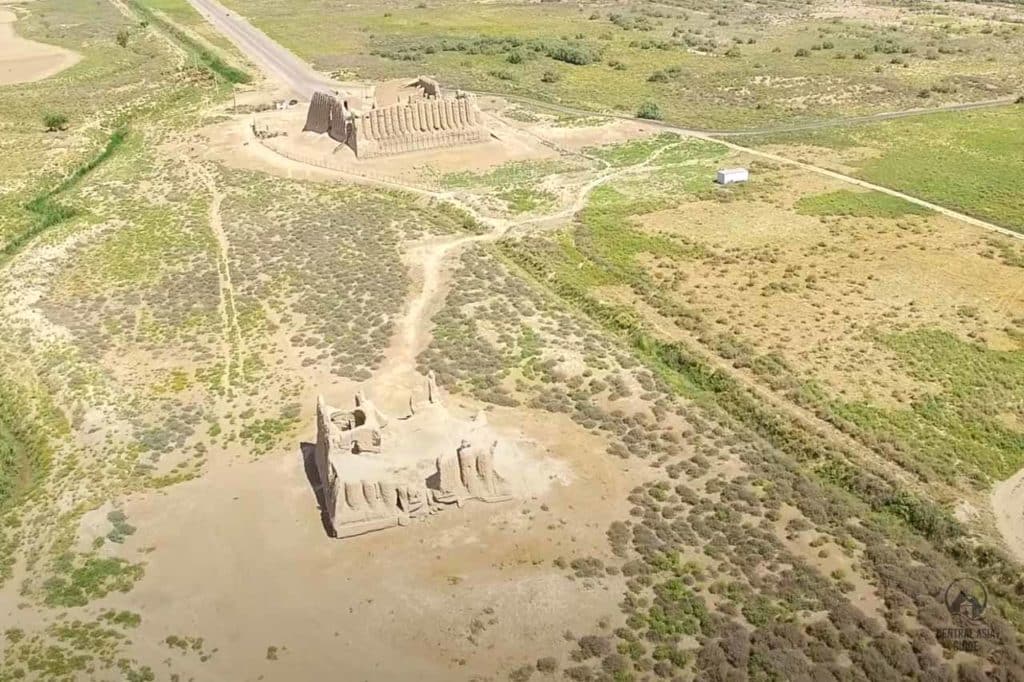
Merv was a major Persian city in Central Asia, on the historical Silk Road, near today’s Mary, Turkmenistan. It was the capital city of several polities throughout its history. In the beginning of the 9th century, Merv was the seat of the caliph al-Ma’mun and the capital of the entire Islamic caliphate. It served later as the seat of the Tahirid governors of Khorasan. In the 11th–12th centuries, Merv was the capital of the Great Seljuk Empire and remained so until the latter’s ultimate fall.
Today, Merv’s glory shines once again thanks to the efforts of the Turkmenistan government, dedicated academics, and UNESCO, which declared Ancient Merv a World Heritage Site in 1993.
Kunya-Urgench
Kunya-Urgench is located in the territory of Dashoguz velayat of Turkmenistan by the left bank of the Amu-Daria River. Urgench was the capital of the Khorezm region, which was part of the Achaemenid Empire. The old town area contains series of Central Asian Islamic monuments mainly from the 11th to 16th centuries. This area has remained a vast deserted land with some remains of ancient fortified settlements, including a mosque, the gates of a caravanserai, fortresses, mausoleums and a 60-m high minaret.
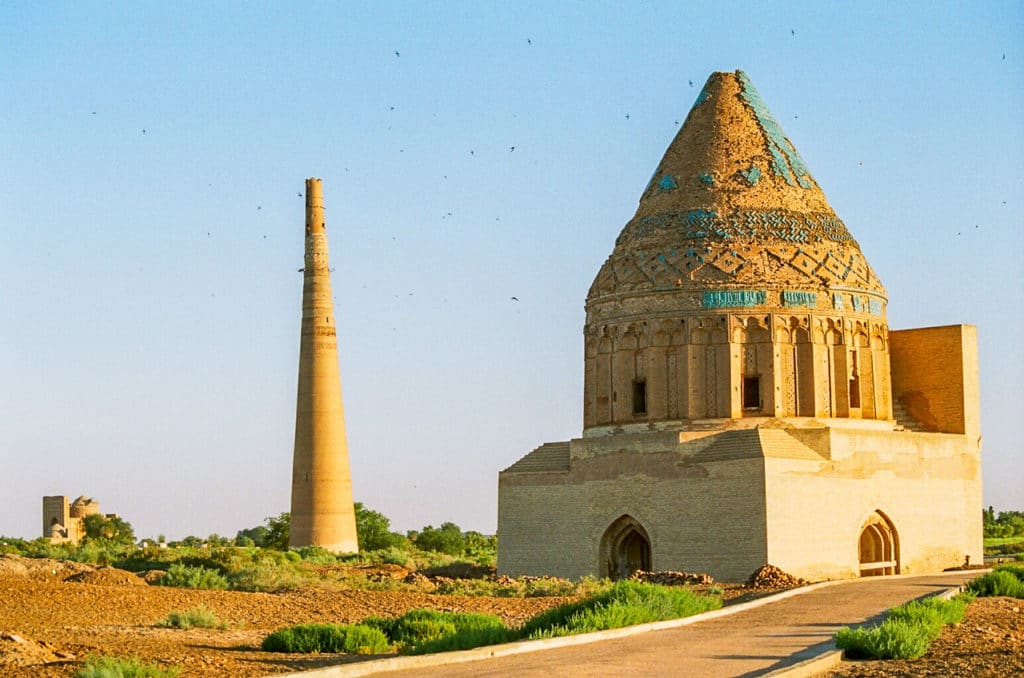

There are constructions from adobe and burned bricks, plain unicameral dome constructions up-going to ancient chartak and buildings with complicated compositions, sometimes with а long history of development, repair and reconstruction. These monuments also demonstrate the evolution of methods of treatment of inner surface of domes from cellular sails to stalactite those times called “muqarnas” and brought to the highest perfection by local masters. The best monuments of this city are distinguished by high degree of decorativeness. They provide prominent examples of classical arabesques in monochrome terra-cotta and bright colorfulness of enamel.
The monuments testify to outstanding achievements in architecture and craftsmanship whose influence reached Iran and Afghanistan, and later the architecture of the Mogul Empire of 16th-century India. The Islamic sacred objects concentrated in this city are exceptionally popular places for pilgrims and serve attractive objects for the international tourism.
Parthian Fortresses of Nisa
The Parthian Fortresses of Nisa consist of Old and New Nisa, indicating the site of one of the earliest and most important cities of the Parthian Empire, a major power from the mid 3rd century BC to the 3rd century AD. They conserve the mostly unexcavated remains of an ancient civilization which skilfully combined their own traditional cultural elements with those of the Hellenistic and Roman west.
Archaeological excavations in two parts of the site have revealed richly decorated architecture, illustrative of domestic, state and religious functions. Situated at the crossroads of important commercial and strategic axes, this powerful empire formed a barrier to Roman expansion while serving as an important communication and trading centre between east and west, north and south.
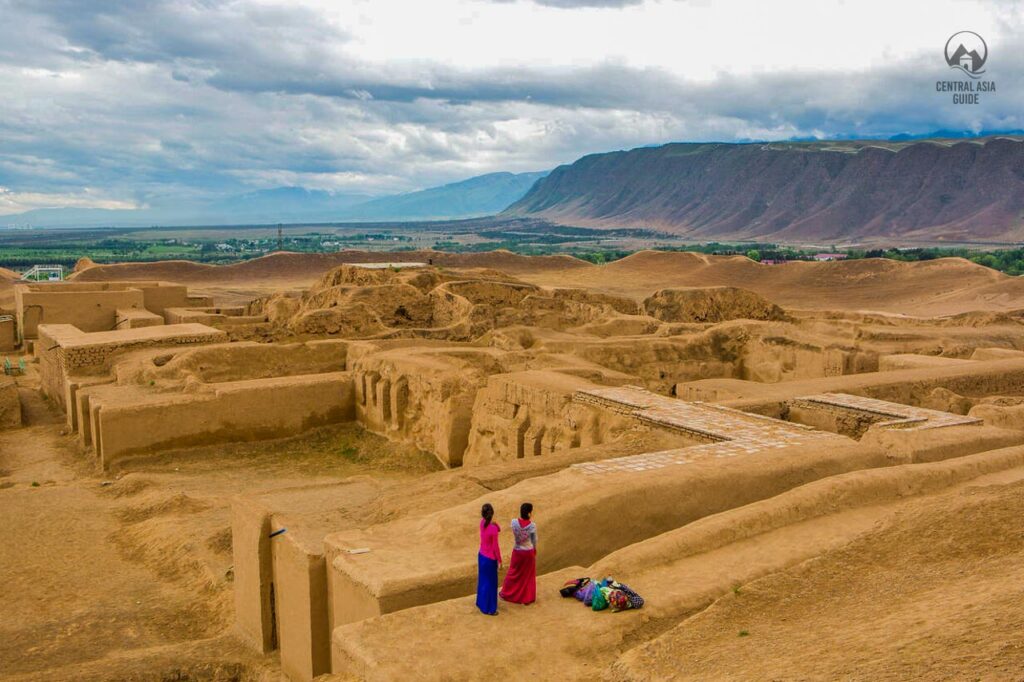
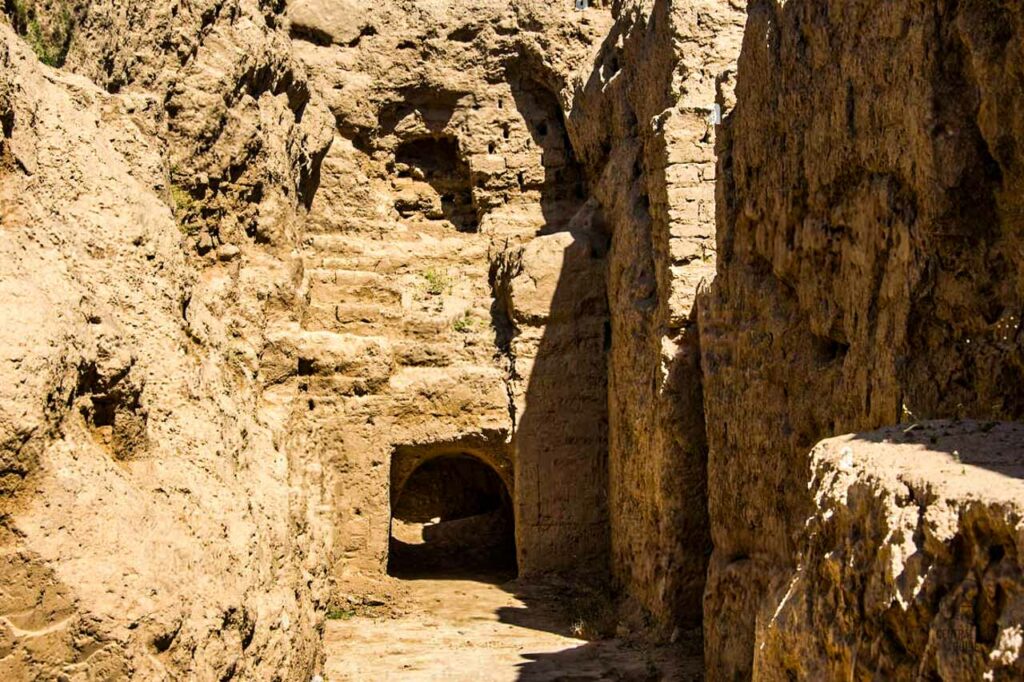
Central Asian multi country UNESCO sites
Western Tien Shan
This transnational property is located in the Tien-Shan mountain system, one of the largest mountain ranges in the world. Western Tien-Shan ranges in altitude from 700 to 4503 m. It features diverse landscapes, which are home to exceptionally rich biodiversity. It is of global importance as a centre of origin for a number of cultivated fruit crops and is home to a great diversity of forest types and unique plant community associations.
The Western Tien Shan UNESCO site consists of the following entities:
- Karatau State Nature Reserve (Kazakhstan)
- Aksu-Jabagly State Nature Reserve – main part in Kazakhstan
- Aksu-Jabagly State Nature Reserve – Karabastau paleontological area Kazakhstan
- Aksu-Jabagly State Nature Reserve – Aulie paleontological area Kazakhstan
- Sairam-Ugam State National Nature Park – Boraldaitau area Kazakhstan
- Sairam-Ugam State National Nature Park – Irsu-Daubabin area Kazakhstan
- Sairam-Ugam State National Nature Park – Sairam-Ugam area Kazakhstan
- Sary-Chelek State Biosphere Nature Reserve Kyrgyzstan
- Besh-Aral State Nature Reserve – main part Kyrgyzstan
- Besh-Aral State Nature Reserve – Shandalash area Kyrgyzstan
- Padysha-Ata State Nature Reserve Kyrgyzstan
- The Chatkal State Biosphere Nature Reserve – Maidantal area Uzbekistan
- The Chatkal State Biosphere Nature Reserve – Bashkizilsay area
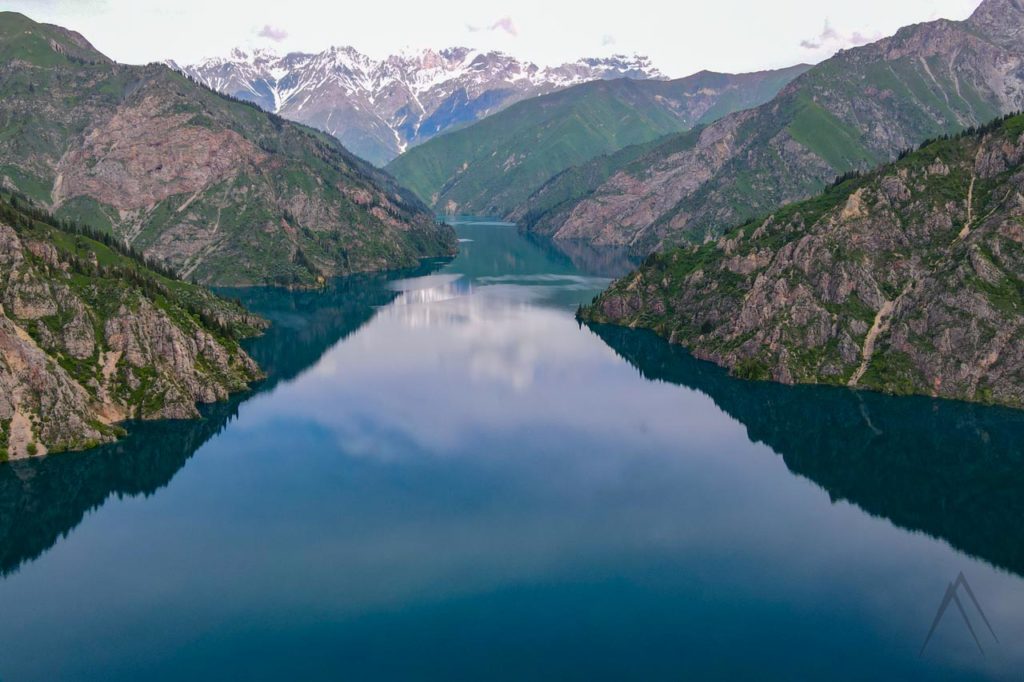

Silk Roads: The Routes Network of Chang'an-Tianshan Corridor
A majority of the Unesco sites of the Chang’an-Tianshan Corridor are in China but there are also many sites in Kazakhstan and Kyrgyzstan that follow the old routes of the northern branches of the Silk Road. Sadly most of the cities and other sights of this heritage have been destroyed by the Mongol invasions and the erosion from wind and rain has destroyed largely what had remained of these silk road strongholds. As the interest towards the sites increase, there are more and more excavations carried out for these numerous sites.


- Starting from East, the most eastern location is the Kayalyk site, next to a small town called Koylyk in curren Kazakhstan, not far from the Alaqol state reserve. The site is still mostly not researched but it has already been found out that it was a thriving Medieval city from 9th to 13th Centuries. Nearby the site there are also ruins of a Buddhist temple.
- Second is the site of Talgar (Talhiz) in Southern Kazakhstan, not very far from Almaty. The city was formed in the 18th century and was living its heyday in the 13th Century.
- Staying in Kazakhstan, we have the Karamergen, which is a settlement (a fortress) that was a stopping place along another route of the Silk Road that was following the shoreline of the lake Balkhash.
- In Kyrgyzstan, the first of tree sites is the most known, the site of Burana tower, also known as the city of Balasagun. Balasagun was founded in the 10th century AD at the site of an older settlement. Along with Kashgar, Balasagun was one of the capitals of the Eastern Khanate after the Karakhanid state divided.
- Second site in Kyrgyzstan, not far from the above mentioned is the ruined city of Suyab.
- Third site in Kyrgyzstan is another large ruined and walled city called the Navekat, not far from Bishkek.
- Returning back to Kazakhstan, Aktobe was one of the largest cities in the Silk Road and has partly reconstructed citadel and several buildings and streets to be viewed.
- Kulan is another Medieval ruined city that has been excavated only marginally.
- Ornek was a thriving fortified site from 7th to 12th centuries on the way to Taraz but now lies in mostly unexcavated ruins. The site’s square shaped walls are very well seen especially with the help of a drone.
- Akyrtas is mostly known for the red rock made ruins of a grand palace that once stood here. Akyrtas is more excavated than the previously mentioned sites and surrounded by several caravanserais.
- Kostobe Medieval city has been a dwelling place apparently during the ancient times but the ruins visible currently are mostly from Medieval times. It was also fortified with tall walls and was partially excavated in the 20th century.
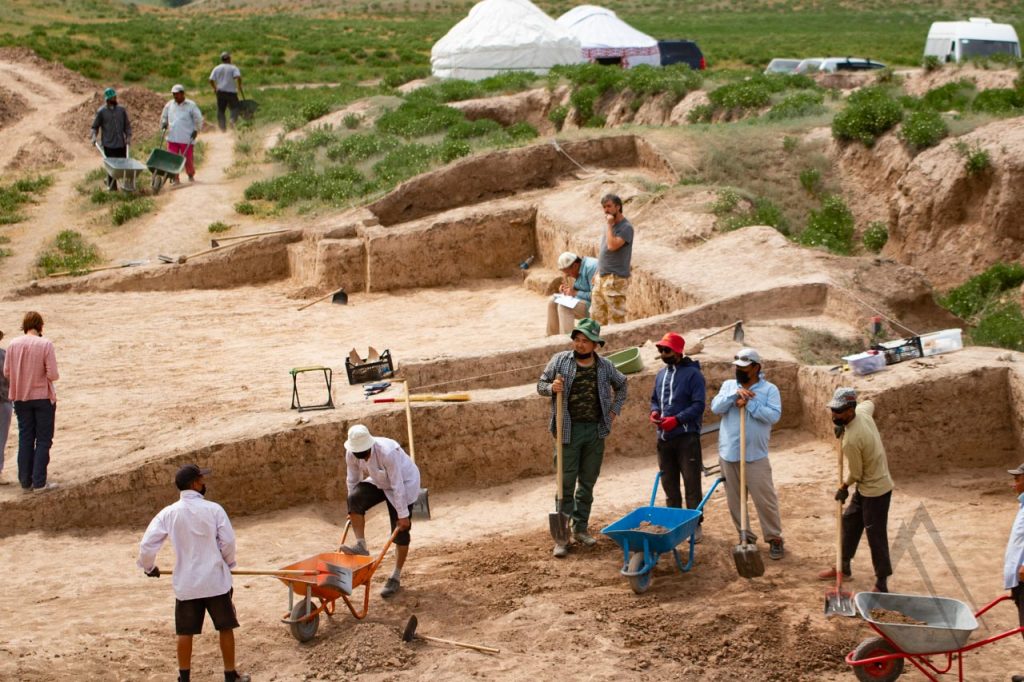
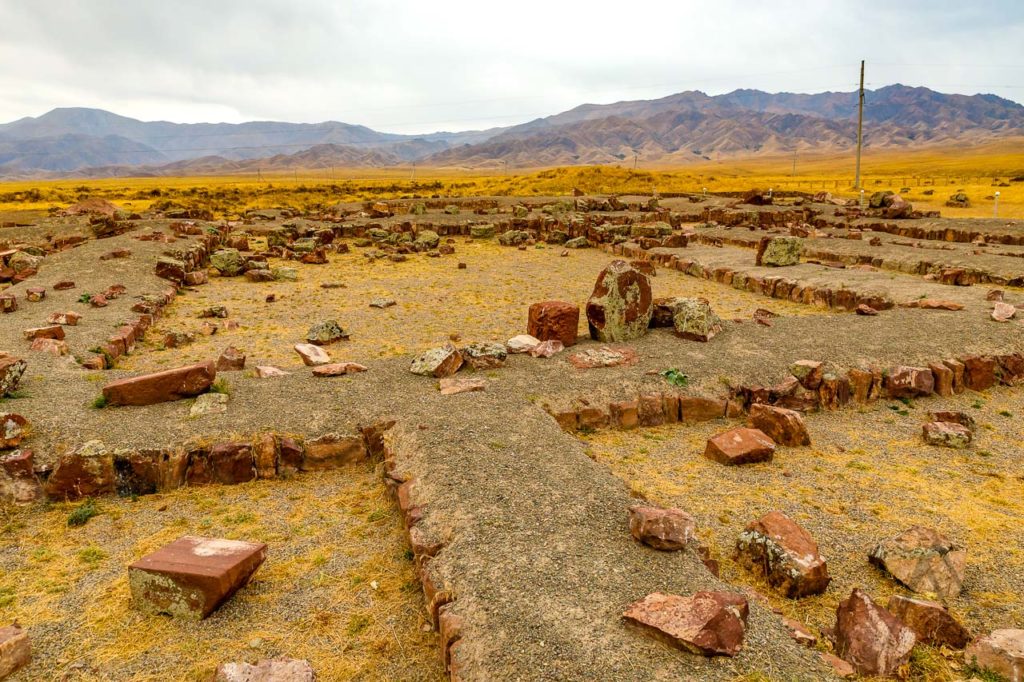
Tentative UNESCO sites in Central Asia
Lorem ipsum dolor sit amet, consectetur adipiscing elit. Ut elit tellus, luctus nec ullamcorper mattis, pulvinar dapibus leo.
Tentative UNESCO sites in Kyrgyzstan
Saimalu Tash Petroglyphs
Kyrgyz Tentative UNESCO sites focus on petroglyphs, silk road cities and fortresses and on some cultural sites in the remote areas of Kyrgyzstan.
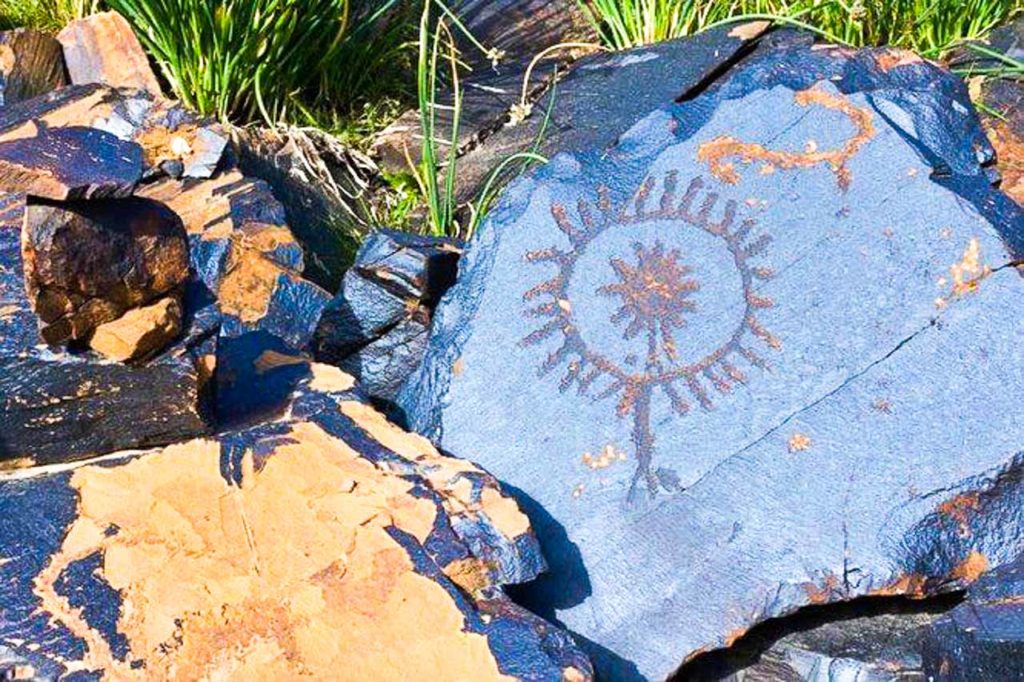
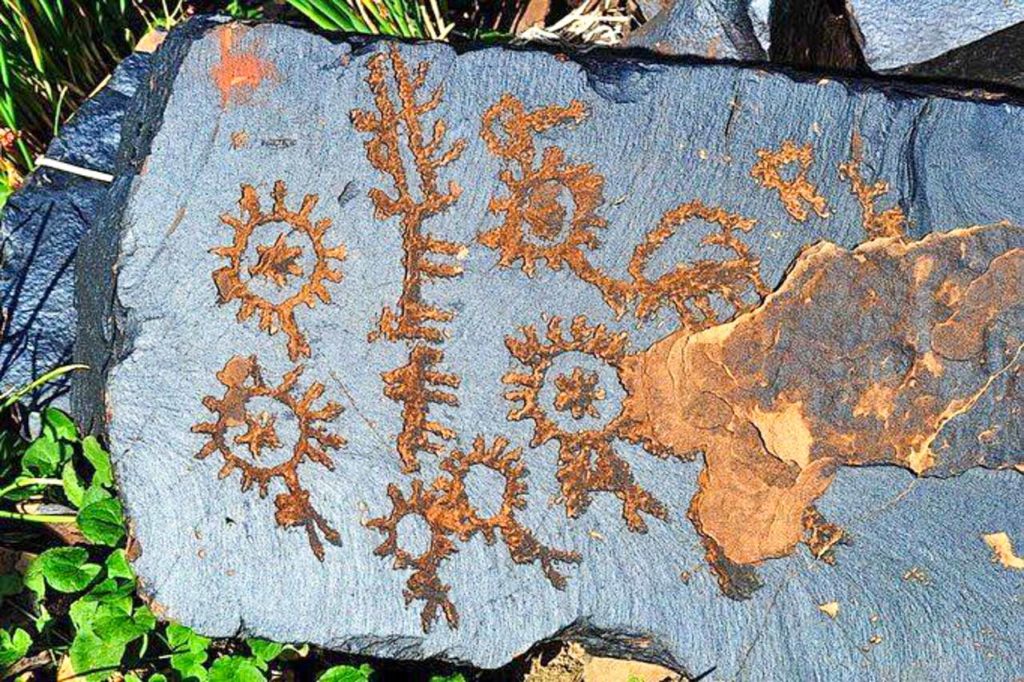
Silk Roads sites in Kyrgyzstan
Nomadic Monuments of Inner Tien Shan
- Koshoy Korgon
- Tash Rabat
- Manakeldy, Shyrdakbek
- Kochkor
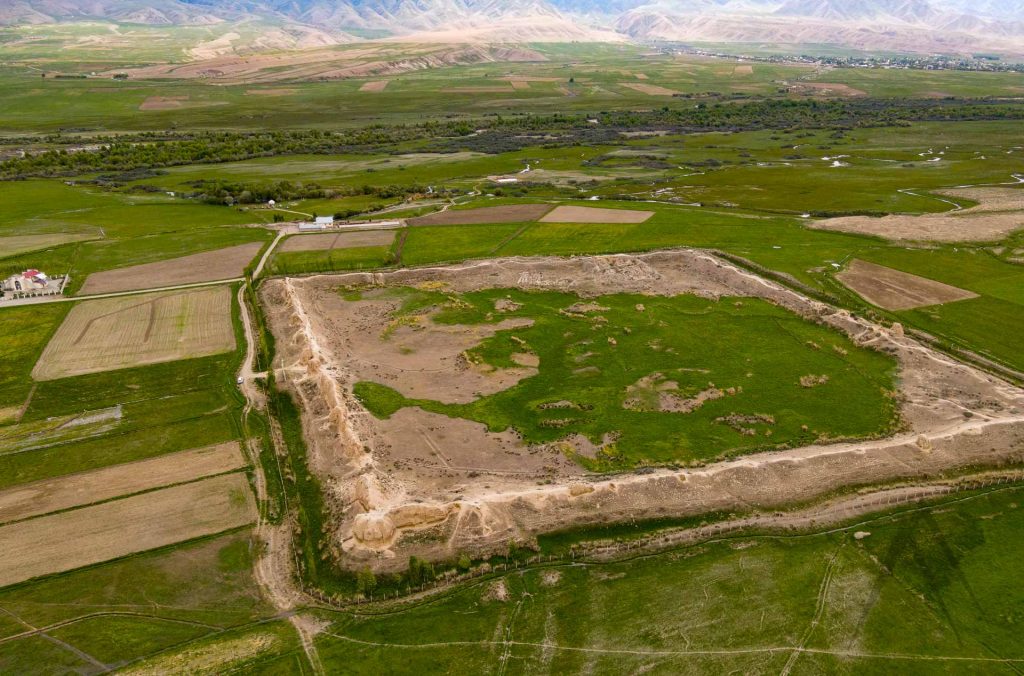
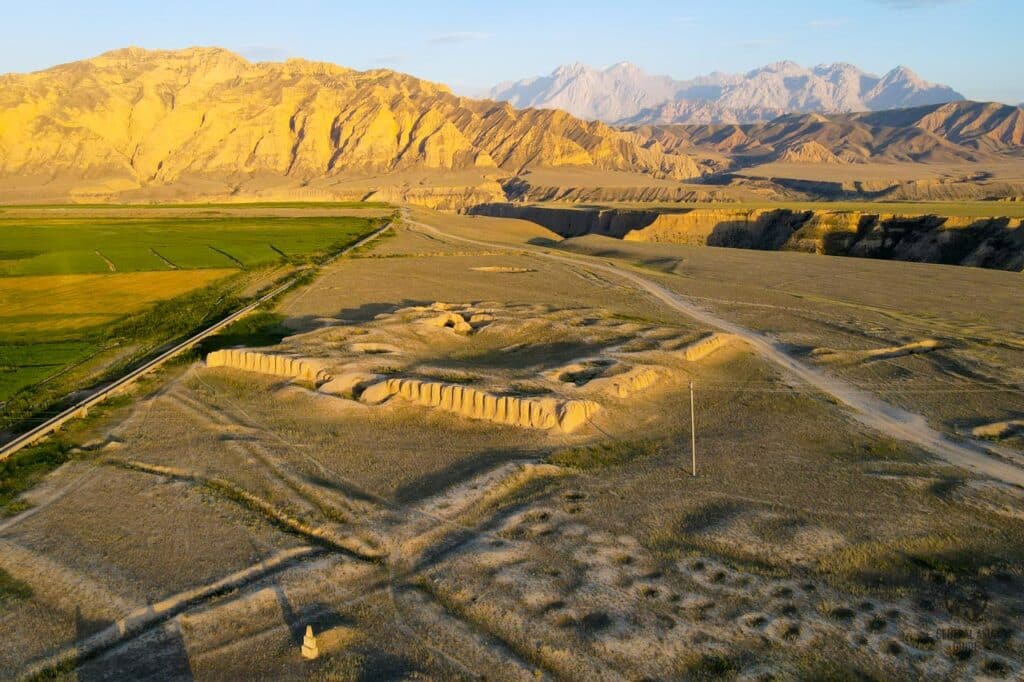
Sites of the southern Issyk Kul
- Barskoon
- Tosor
- Khan Dobo
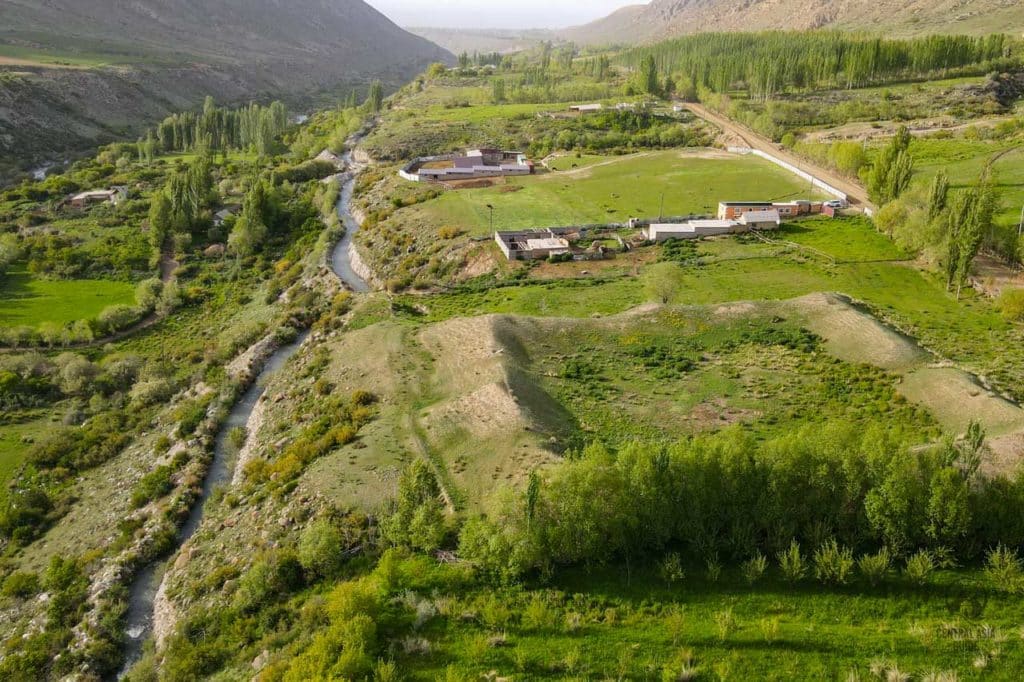
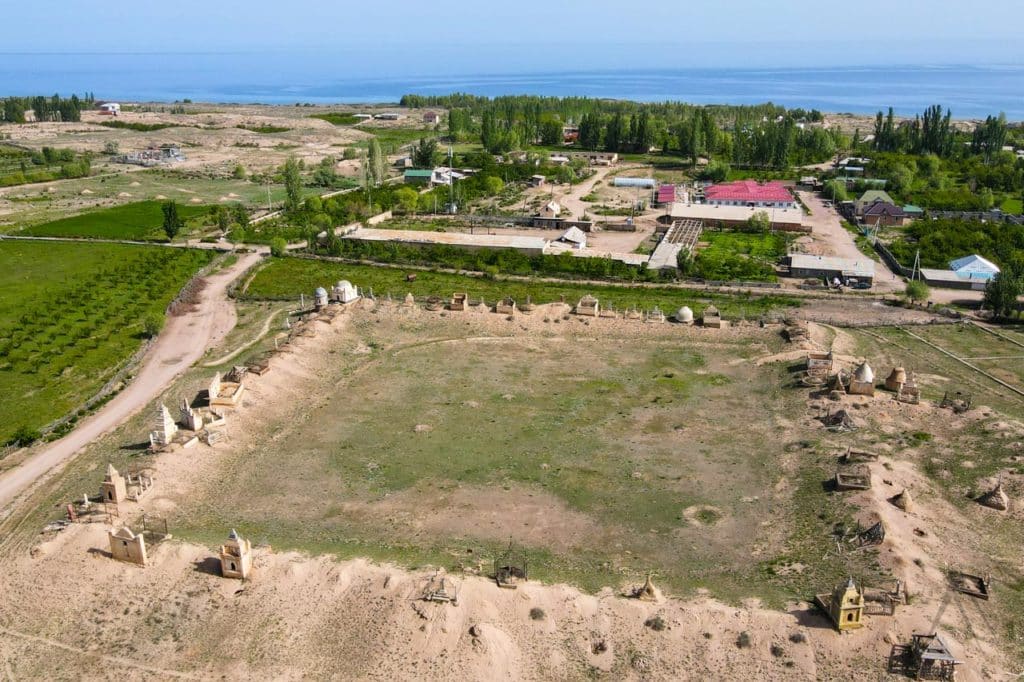
Medieval sites in the Upper Chui Valley
- Navekat (Krasnaya Rechka)
- Suyab (Ak Beshim)
- Balasagun (Burana)


Cultural environment of Manas Ordo in Talas
- Karool Choku
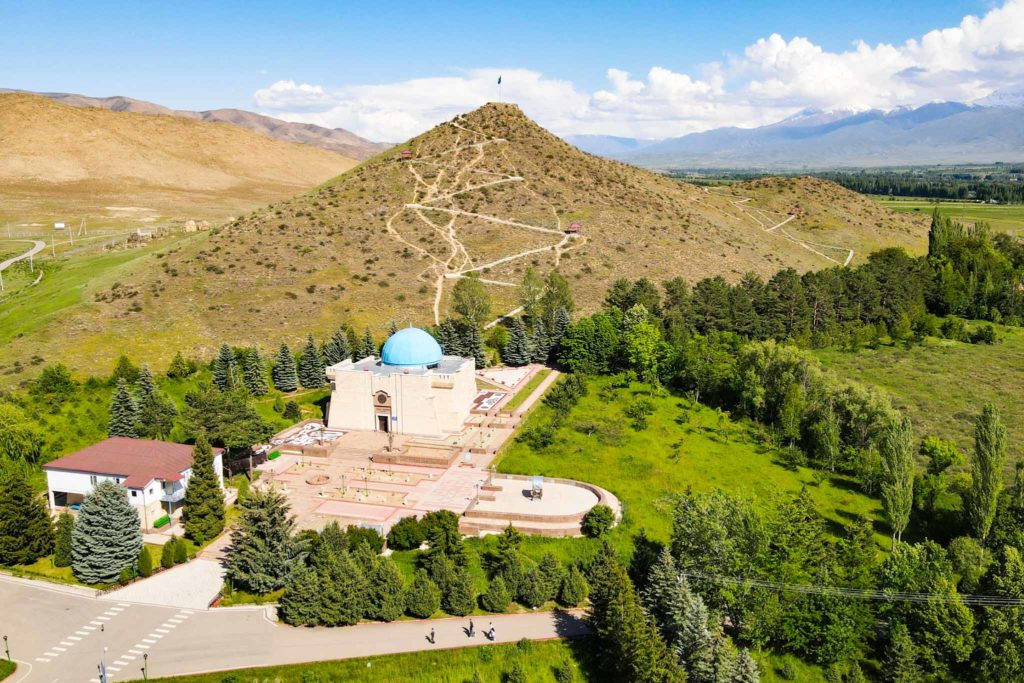
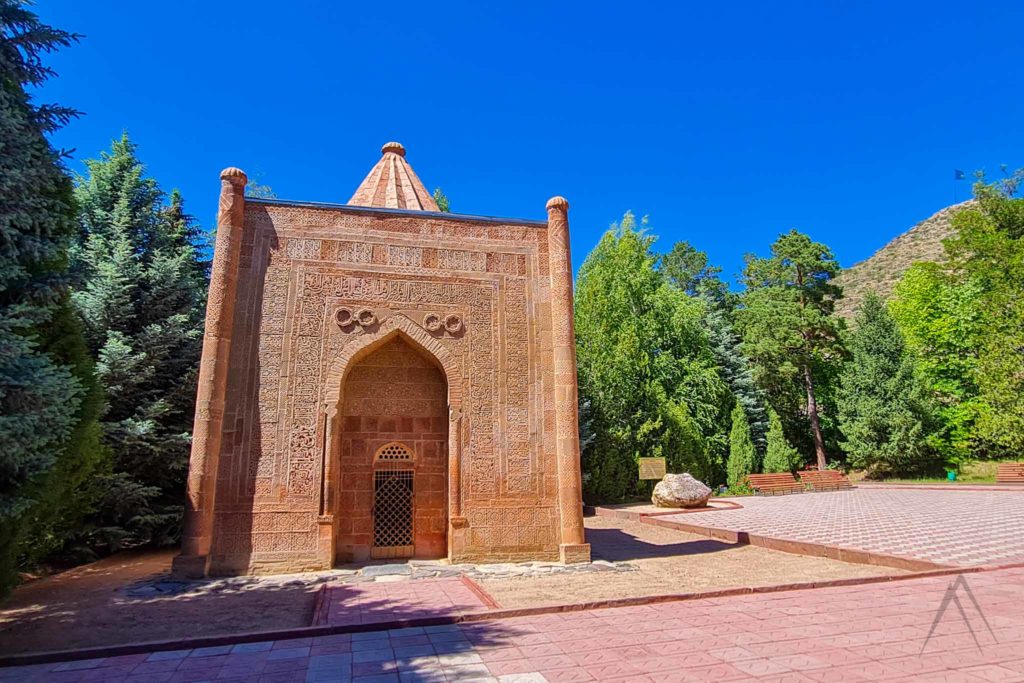
Cultural landscape of Safid Bulan
- Shakh Fazil mausoleum
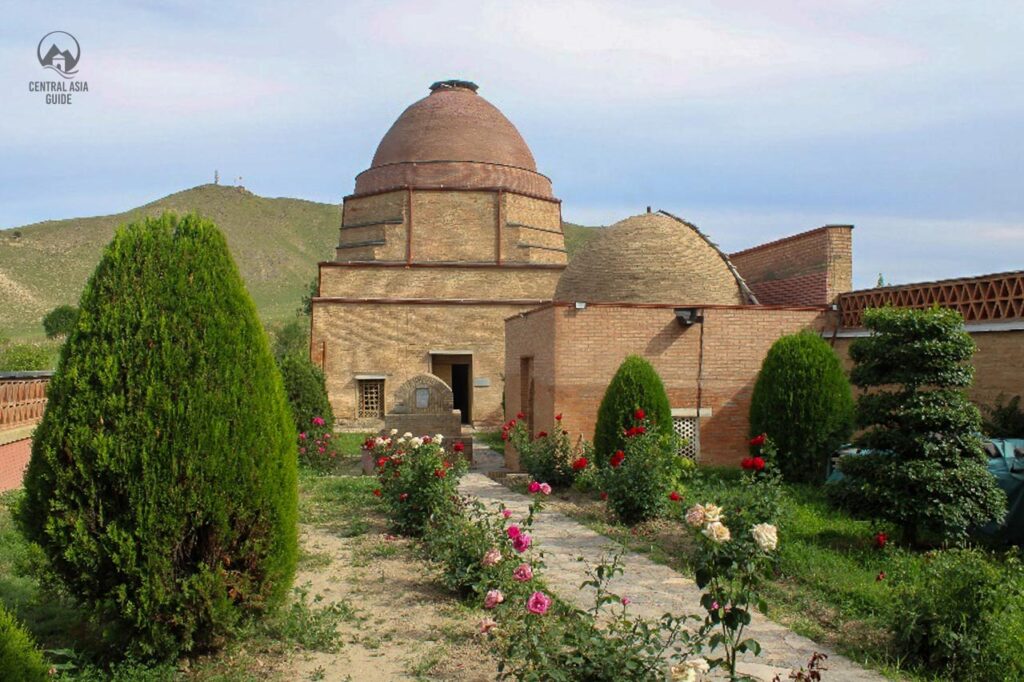

Uzgen and Shorobashat
- Uzgen
- Shorobashat
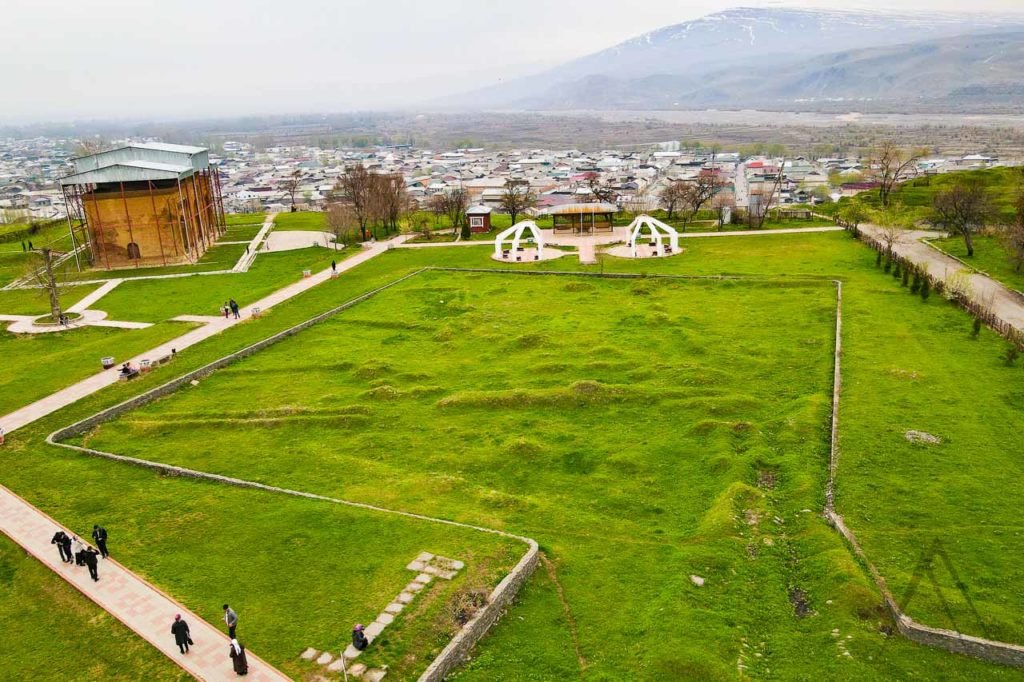
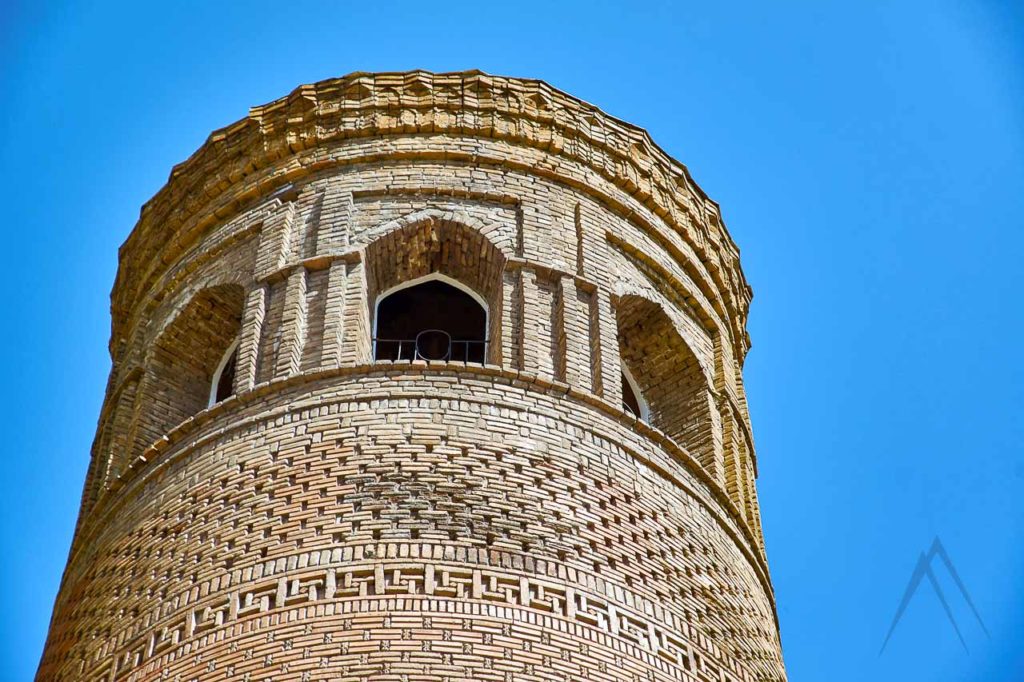
Tentative UNESCO sites in Uzbekistan
Ak Astana Baba
Ak Astana Baba mausoleum is situated on the territory of large and ancient burial ground and built in honour of the Abu—Khu Khureyra considered as prophet’s associate in Eastern Uzbekistan, not far from the border to Tajikistan. The mausoleum has centric composition, square in plan and oriented to all World’s parts. The cubiform construction is flanked by guldusta towers and crowned by well proportioned sphere conical dome. Octahedron with arches is decorating dome’s ceiling. Northeast, northwest and southwest walls of the interior have rather deep lancet bays with two twelvesided columns. The room with grave stone sagana is lightened by hole in sophit of the entrance arch. Façades are decorated by figured brickwork with wide vertical seams. Upper row of brickwork is sloped. Socle, the first ring and two rows of brickwork are made from large bricks.


Khanbandi (dam)
Khanbandi dam is situated in the Zarafshan river basin. 8 channels with 680 dams were built at the X—XIII centuries in Samarkand area and only 4 dams of such scale have been preserved. The dam of Khanbandi was built at Oslan in Pasttaga gorge. Upper length is 57.75 m., lower is 24.35 m., altitude is 15.25m. It has been constructed from cut granite slabs based on water resistant solution. 9 coneshaped holes which made in different altitudes were regulating the water flow. The basis of the dam is 4 times thicker than the top. The length of the created reservoir is 1,5 km, the width is 52 m near the dam and 200 m near the gorge.


Complex of Sheikh Mukhtar Vali mausoleum
The Sheikh Mukhtar longitudinal shape mausoleum complex was erected in the XVI century above the grave of Ostana settlement founder Sheikh-Mukhtar-Vali, who died in 1287. The composition of this multi-cupola and multi-volumetric monument was built on the long axis from east to west. The plan of the construction has no definite geometric outline but is complicated by annexes. The hall of large mosque and smaller mosque behind emphasize the long axis in a complicated asymmetric composition. The big and small halls are covered by arched sails of different shapes. The burial vault is overlapped by dome on the shield sails. The floors of store rooms have different kinds of the arches. The facades are decorated by baked bricks. All interiors are plastered by gunch. The grave stone is made from baked bricks, with stairs at the basis. The carvings of three wooden doors make them special and distinctive.


Vobkent Minaret
The minaret in Vobkent (1196-1197), is quite similar to the minaret of Kalyan in Bukhara and differs from it mostly by decoration and is few meters shorter. It is also one of the few buildings in Central Asia that survived the Mongol attacks. The height of the Vobkent minaret from the bottom up to the top of the basic column is 40,3 m. The height of 12-cut socle is 2,3 m. Diameter of the basis of the trunk is 6,19 m. Diameter of the top of a trunk (under the lantern) is 2,81 m, diameter of the lantern 3,66 m, diameter of the basic column is 1,05 m. The trunk of the minaret has an entasis. First three strips from below are divided only smooth hem from brick into the edge. Then wide foreparts alternate with narrow paths. The fourth strip contains the historical inscription from which it the time of construction was established.
The Vobkent minaret was constructed by the son of Sadr Burhaniddin Muhammad Bukhara Sadr Burkhaniddin Abdalaziz II, son of Sadr Hasanaddin Omar, the son of the founder of Sadr dynasty. The fifth path represents the abstract stylization «under kufi», the sixth – decorative lattice, the seventh – the prayerful formula, three followings – again lattice. Under the lantern eight-final rectangular starts with inserts from glazed brick. The third relief inscription from the plates with the handwriting inscription is above it. Vobkent Minaret can be visited while driving between Bukhara and Gijduvon.

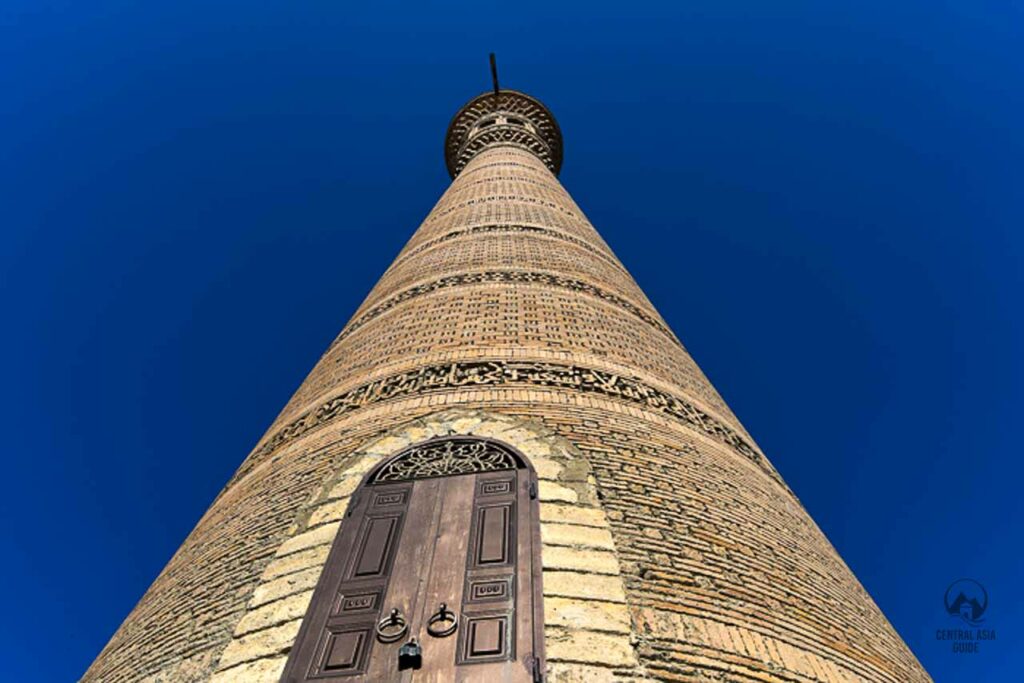
Desert fortresses of Ancient Khorezm
Desert Castles (Kalas) of Ancient Khorezm consists of following sites: Toprak Qala, Ayaz Qala, Koy-Kirilgan Qala, Big Guldursun fortress, Pil Qala, Anka Qala, Kurgashin Qala and Djanbas Qala in current Karakalpakstan. In addition to the abovementioned, there are tens or even hundreds of more ruined fortresses and oasis cities in the Khorezm & Kyzyl Kum desert region south from Aral Sea. Most of these sites can be easily visited while driving between Khiva and the Aral Sea.

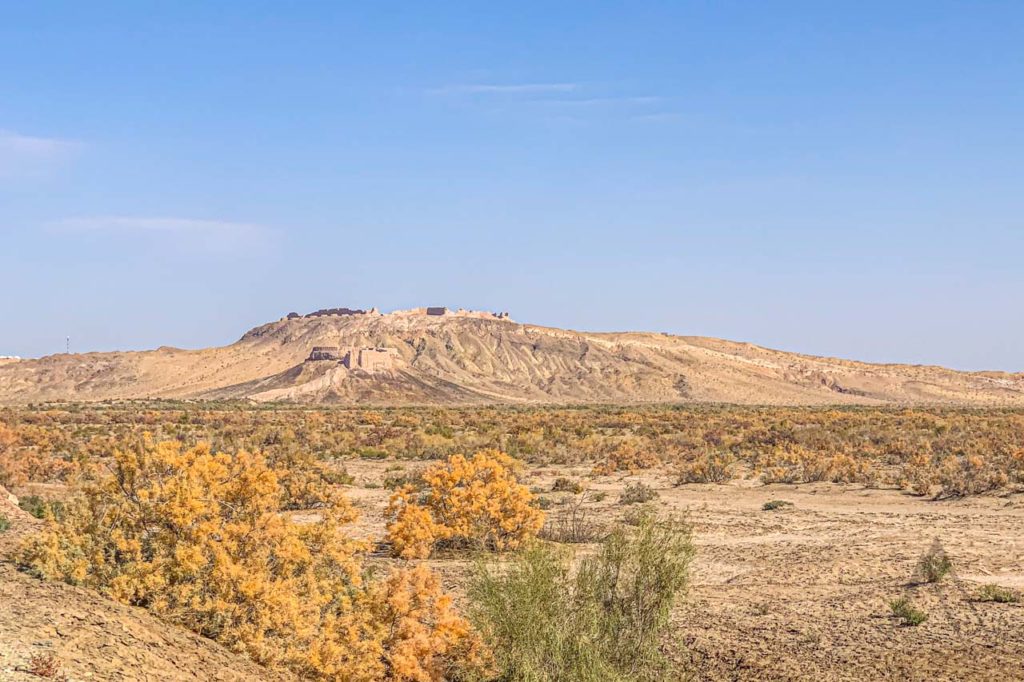
Khazarasp
Khazarasp (Hazorasp) is one of the most ancient cities of Central Asia. Many ancient authors of East At-Tabbari (XI century), Arabian historian Al-Istakhri (X century), Beykhaki (XI), Djuveni (XIII century) and many other mention this city. It is a coeval to Memphis, Rome, Athens, Merv, Samarkand, Bukhara and many other cities.
Khazarasp was the main advanced post of Khorezm state on the Great Silk Road and the largest trade center in the past. Currently the ruins of this ancient city are located in the middle of the modern Hazorasp city and partly inhabited by the locals. The city had been surrounded by fortifications. Walls were strengthened by towers but only 12 towers are left now. In the southeast corner, rises above the citadel tower Dev-Solgan. The height of the walls of kept tops is 12 m, and without them – 10 m. In some places of the wall are totally destroyed. They are combined from pahsa (adobe wall) and adobe bricks.
Archeological researches in Khazarasp confirmed that it has arisen based on the settlement in the middle of I millennium B.C. In the beginning of the VIII century Khazarasp is known as one of the three most strengthened and large cities of Khorezm. It appears that the city did not arise spontaneously but that the unique center, has been constructed at once according to a plan.
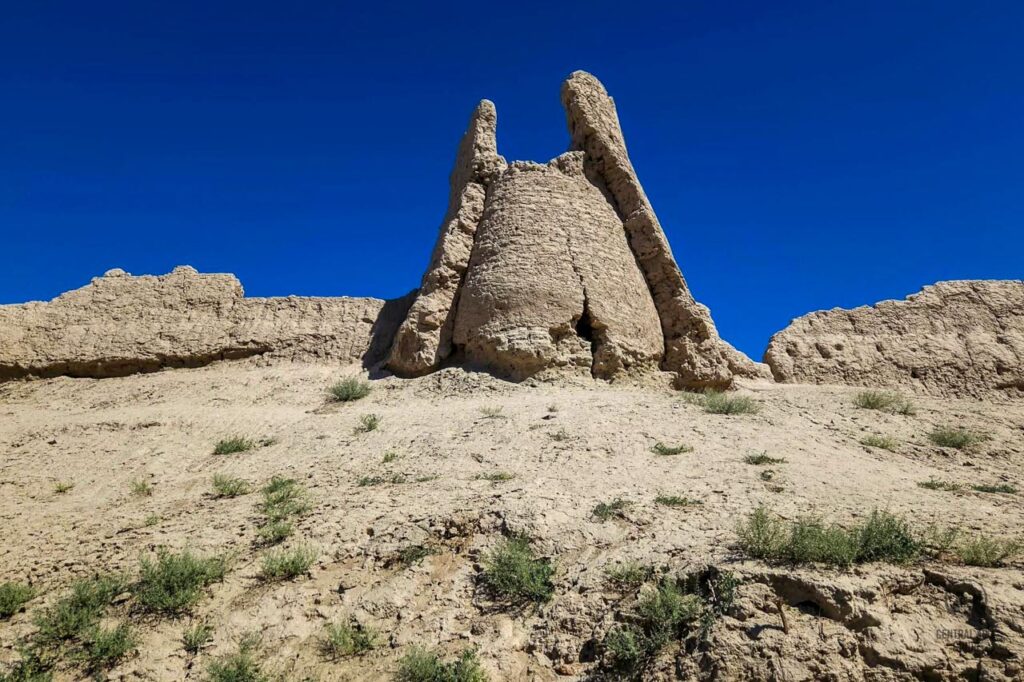
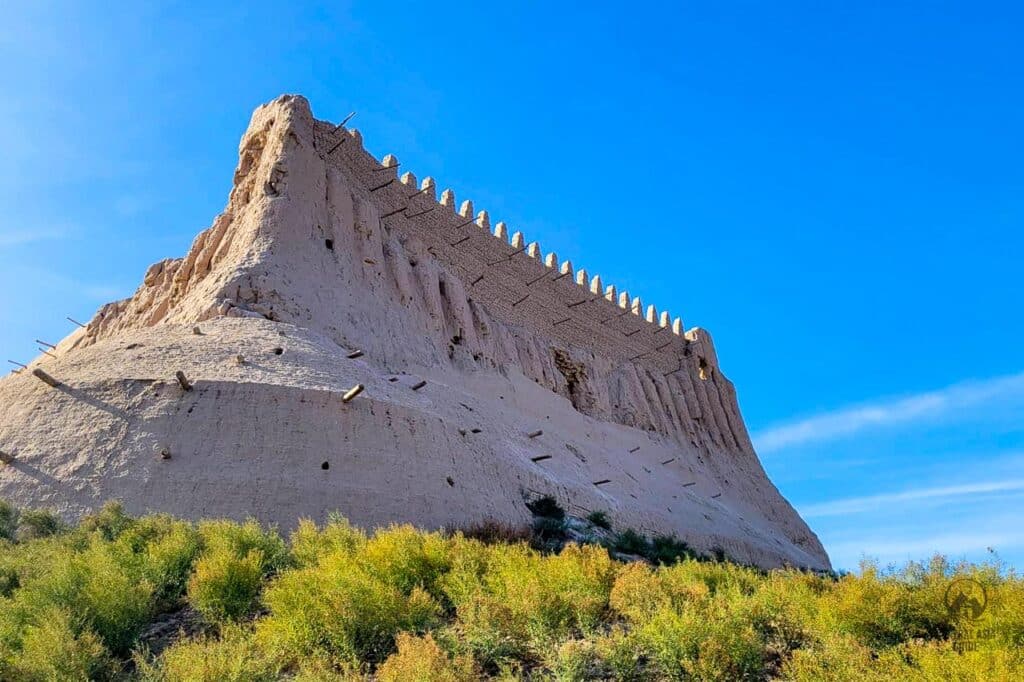
Mir Sayid Bakhrom Mausoleum
Mir-Sayid Bakhrom Mausoleum is laid out from backed brick with the main facade issued in the form of a portal in the old part of Navoi called Karmana. On an axis is located the superficial arch niche in 2,13 cm width with the rectangular doorway and arch window above them. From the external part, the arch frames with large inscription with significant losses but recent reconstruction.
The facade flanked cut columns also is designed by the II-shaped frame in the form of the repeating geometrical figure with verge “plait”. The dome is based upon on the octahedron in the interior. The interior of the mausoleum in an original form has been entirely decorated by the groove on the ganch.
The original gravestone deserves special attention in the mausoleum, which originally has been made by wood, and in the consequence, large plates from the black stone covered it. Mir-Sayid Bakhrom Mausoleum has features similar to the mausoleum of Samanids in Bukhara, Arab-Ata in Samarkand region and mausoleum of Oq Ostona Bobo in Surkhandarya region.
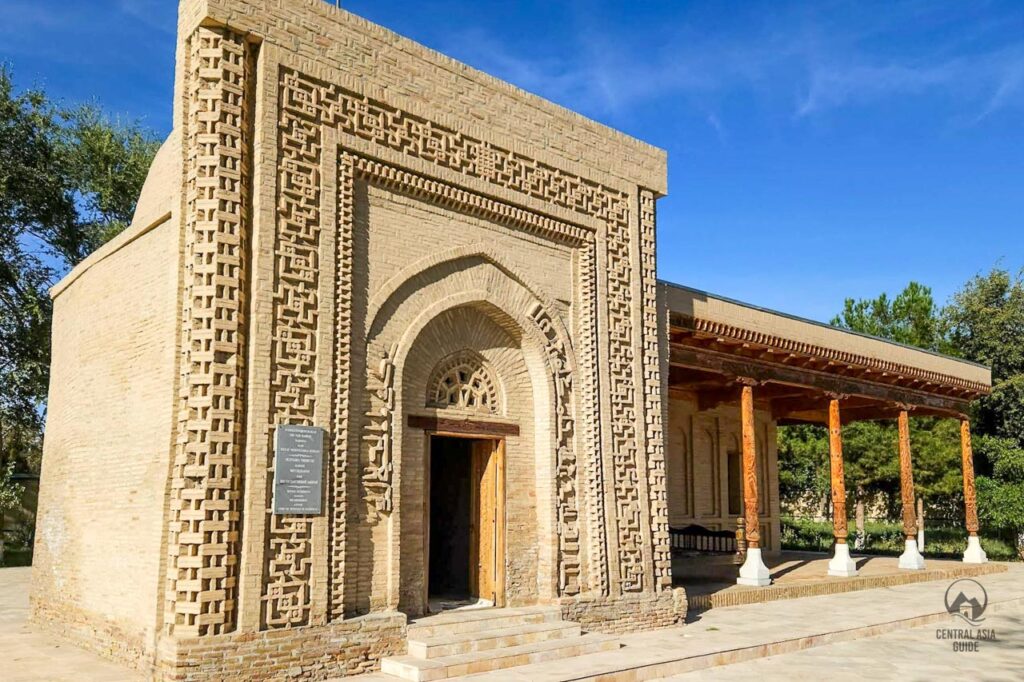
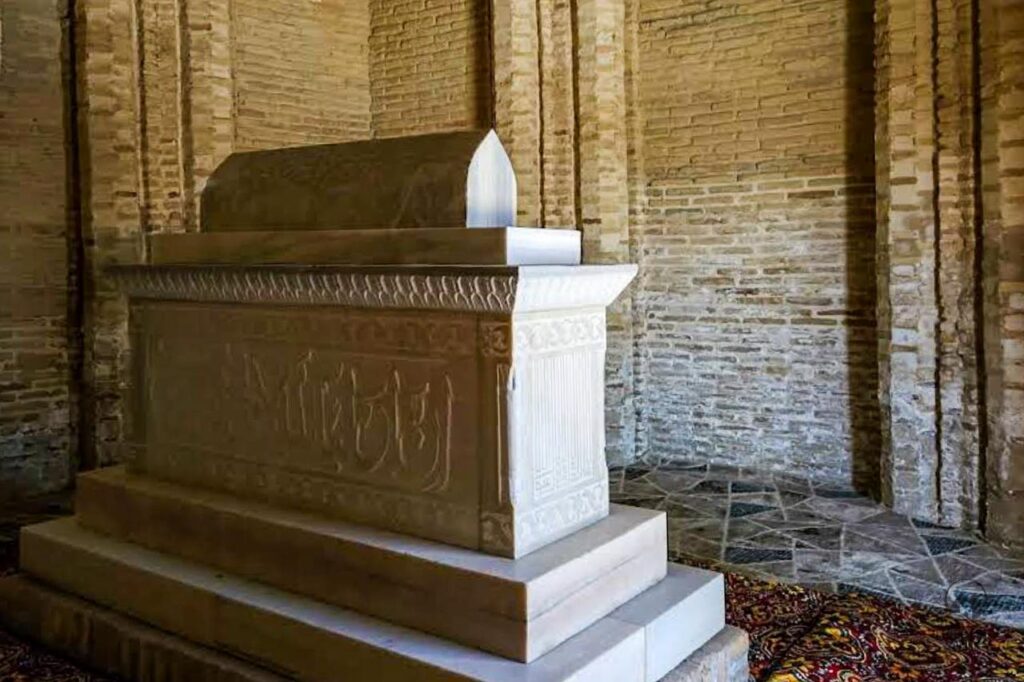
Rabati Malik Caravanserai
Rabati Malik Caravanserai was constructed according to the order of Karakhanid Shams-al-Mulk Nasr, son of Tamgachkhan Ibragim who ruled in Samarkand from 1068 until 1080 AD. Only the portal has remained somewhat intact from this huge caravanserai and is now restored. Otherwise, only lowest parts of the walls remain still showing the layout of the caravanserai. The portal of caravanserai (peshtak) with the central lancet arch of niche tops a rectangular doorway. The arch is concluded in the П-shaped frame executed from the carved terracotta in the form of eight-final stars connected with each other, limited by intertwining tapes. Ring is decorated by the Arabian inscription. On overhanging walls, under the layers of repair plaster the rests of ancient ganched plasters with figure of vegetative character. The portal, as well as all caravanserai has been laid out from adobe brick with the subsequent facing backed bricks. The caravanserai occupies an area of 8277 sq.m.
The Rabati Malik caravanserai is one of the largest constructions of similar type in the territory of Central Asia and has successive relations with old traditions of constructions. In particular, an architectural decor from the carved and coupled bricks present in the sources of building techniques on the ensemble of Sulton-Saodat in Termiz city, mausoleum Samanids and Namazgoh in Bukhara. Separate analogues can be seen on the architectural monuments of Karahanids’ capital in Uzgen city. The caravanserai is located on one of the routes of the Silk Road and next to it, on the other side of the modern road, there is an old water storage that was used by the caravanserai.
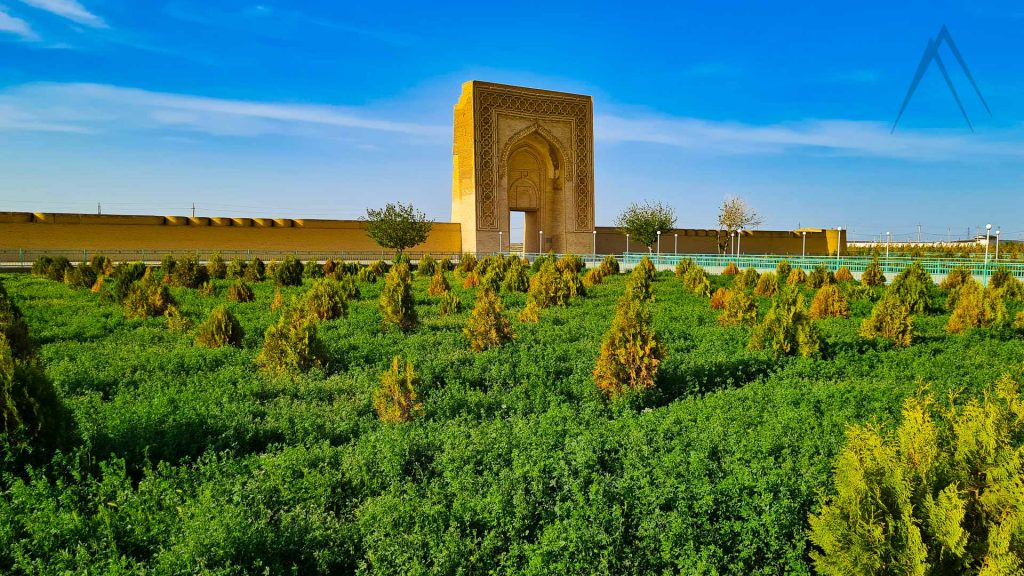
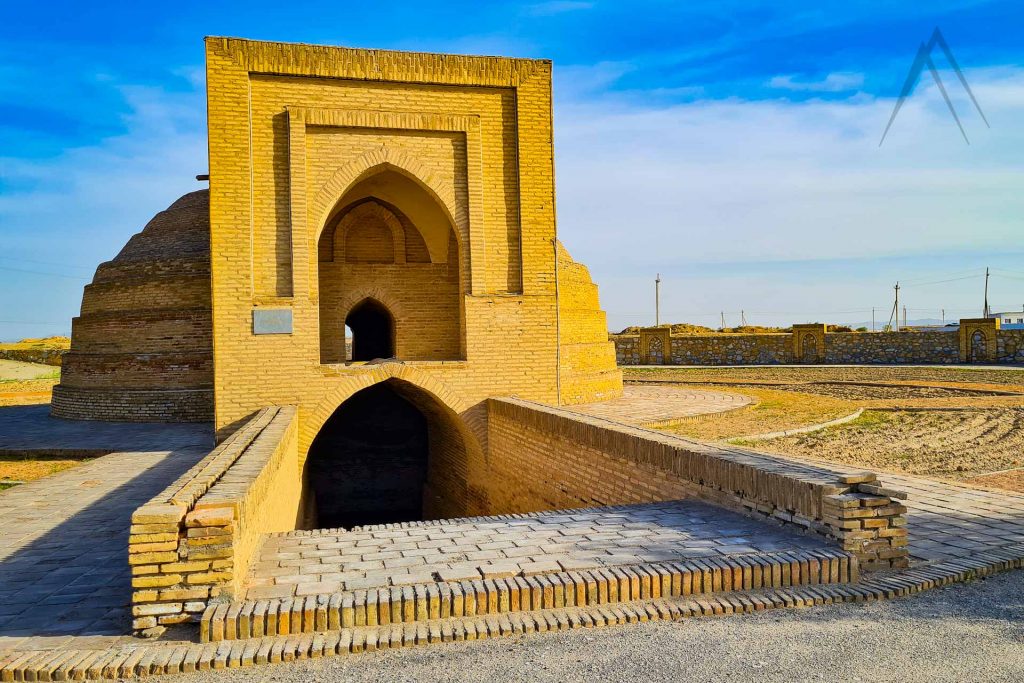
Bahoutdin Architectural Complex
The architectural complex of Bahoutdin consists of several nonsimultaneous constructions and is located north from Bukhara.
1. The most ancient is the dahma (gravestone) of Bohoutdin Nakshabandy, reveted by marble blocks and enclosed above an openwork marble lattice. The tomb of Bohoutdin is located on the top platform with the marble gravestone and stele. Small khauz (basin) settles down at the north, as reveted by the marble as well.
2. The following site of the complex is Saho-khona, representing quadrangular pavilion of the type of rotunda. A construction of four-arch, flanked on the corners of minaret shaped turrets, which are completed by small domes.
3. At the complex, there is a mosque called Khakim Kushbegi, with the flat trabeation, supported by the two columns and forming six painted plafonds. From the south to it adjoins ayvan with five columns and the same amount of painted plafonds. From the northern part is located another ayvan, also with five wooden columns, beam ceiling and vassa.
4. The mosque of Muzaffarkhan also a component of the complex has bricked walls. Flat beam ceiling supported by the wooden columns and ayvan on the four columns with five various painted plafonds.
5. From the northern part of the mosque, the small minaret constructed from the backed brick with lantern from eight arches towers.
6. Small madrasah belongs to the complex as well.
7. Abdul-Lazizkhan khonaqo is located in the northwest part of the courtyard. The composition of khonaqo has constructed in classical method on the square plan. The entrance into the complex was from two gates, named as Toki-mionka, in the form of the small arched-dome construction and Khodja Dilyavar gate. In front of the main khonaqo facade is located the necropolis – Dahman-Shahon (a cemetery of governors). It represents 6 rectangular sufa in height of up to 2,5 m with the reveted walls from marble blocks. Besides of that, there are 2 wells and 2 khauz (basins).

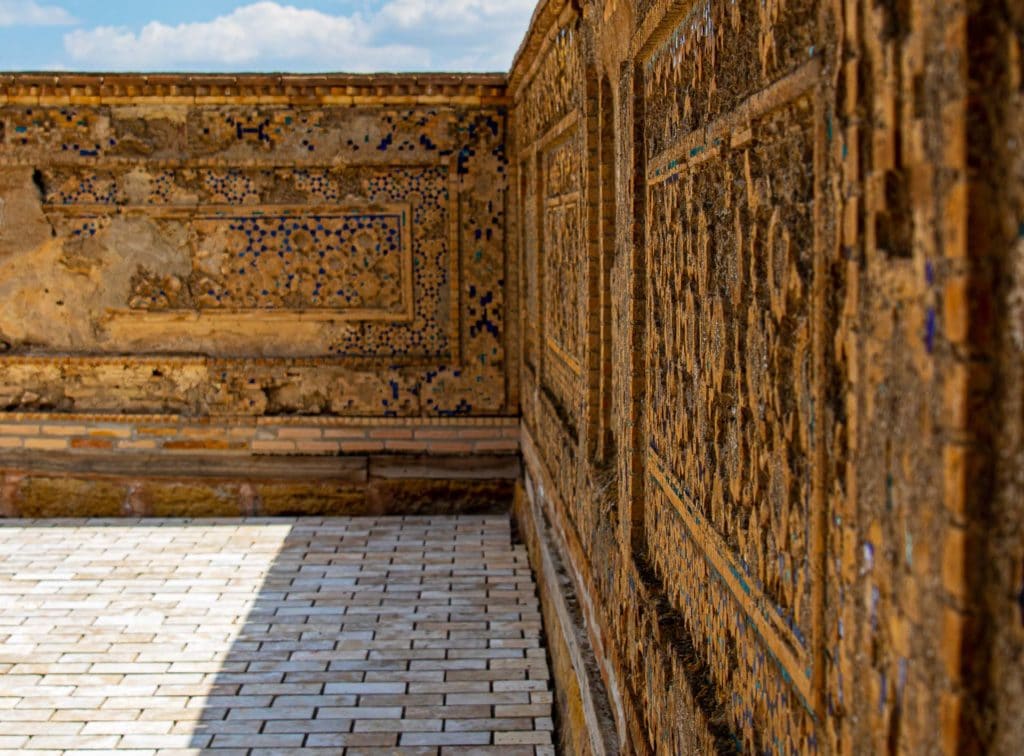
Page updated 7.6.2025 Work in progress!